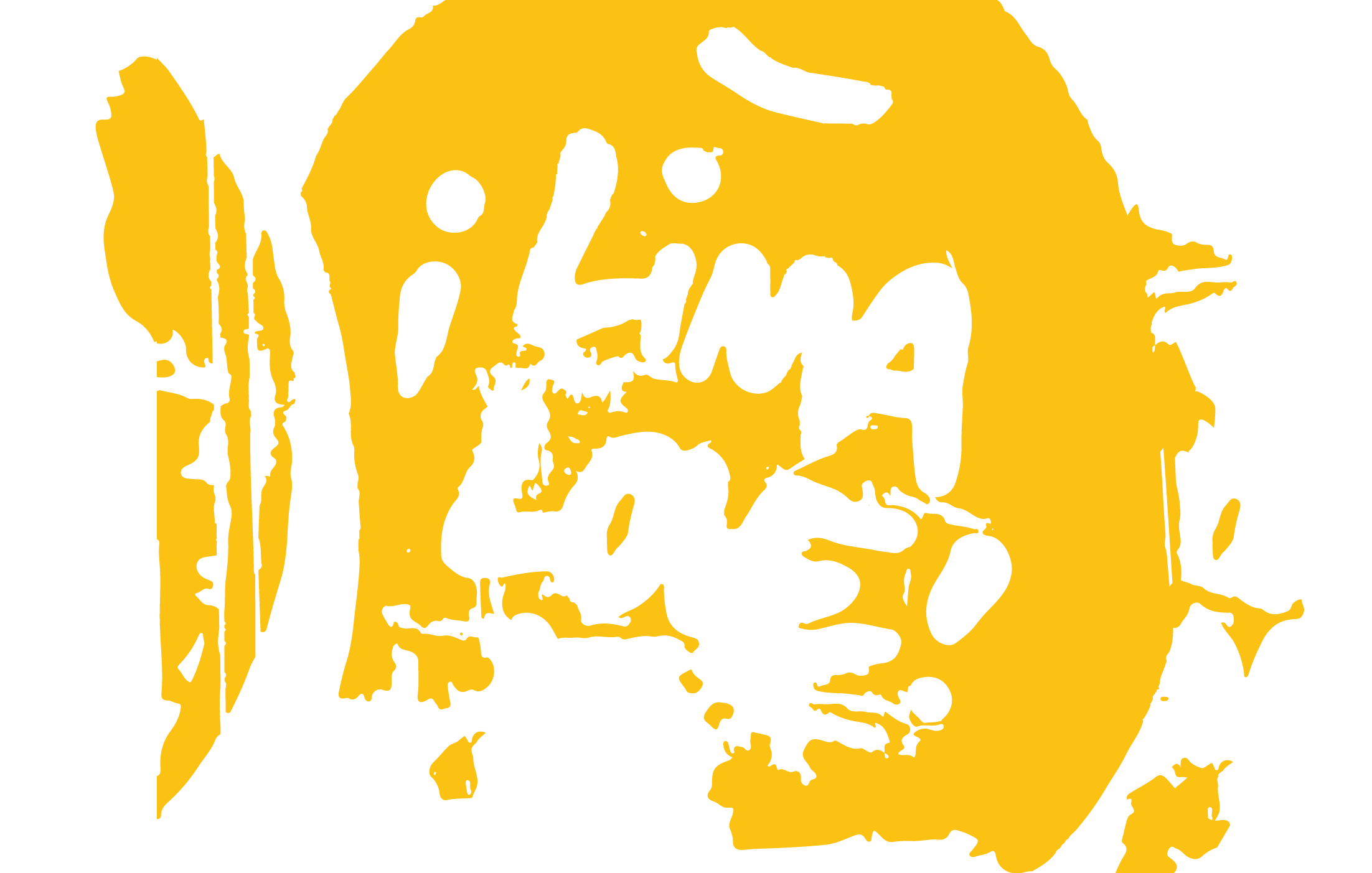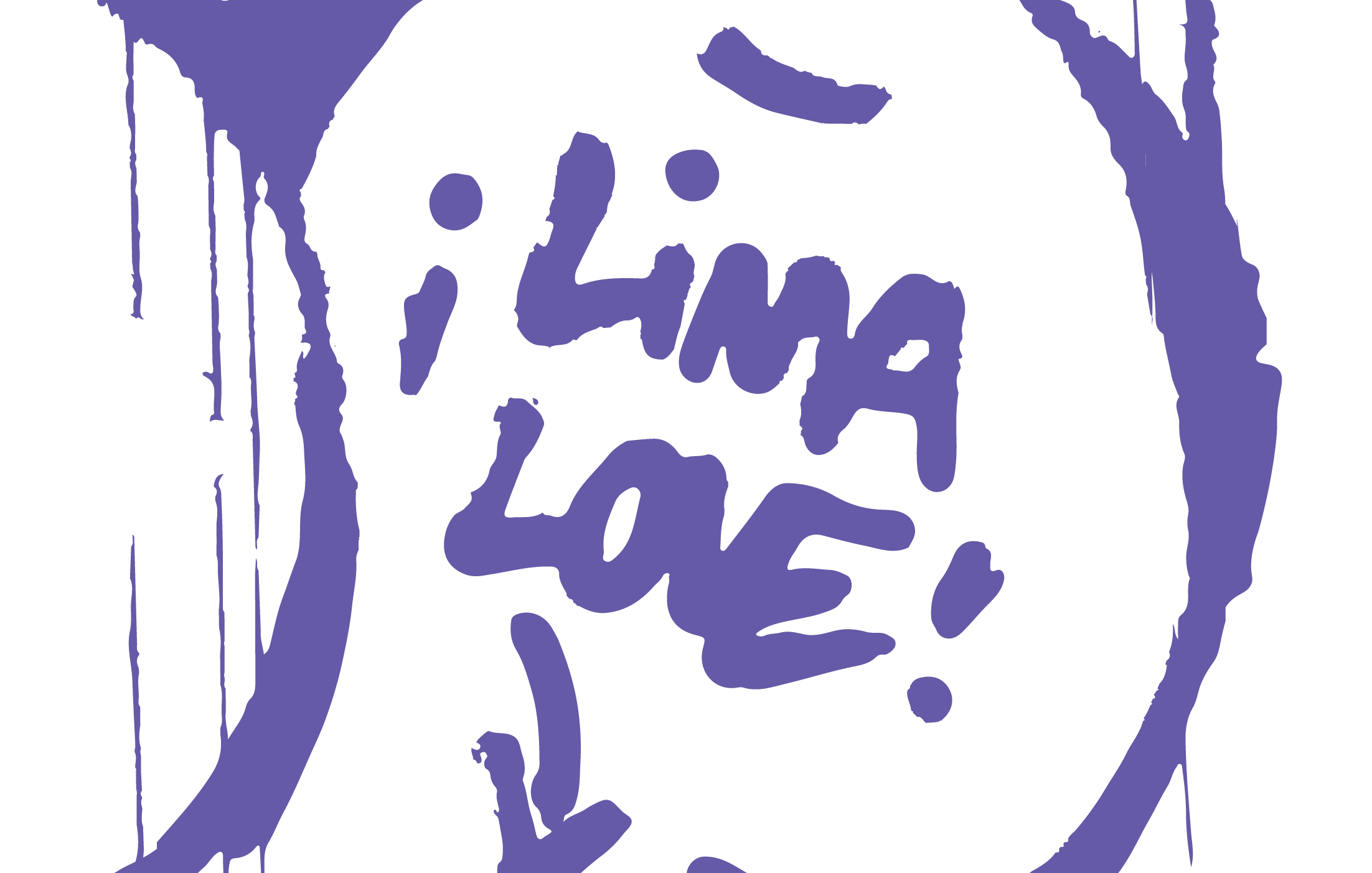Central
Last night, Natalie, Janet, Sue and I had dinner at Central, the fourth best restaurant in the world. It. Was. Incredible.
We arrived at 7:45 (as far as we can tell, there’s only one seating, we were among the first to arrive and the last to leave), and were seated at what we think is the best table in the house. The restaurant has an open kitchen, behind an enormous glass wall, and we were maybe 20 feet away from the pass. We could see chef Martinez, dressed in a button up, expediting, tasting, plating, and calmly floating all over the kitchen. Too cool.
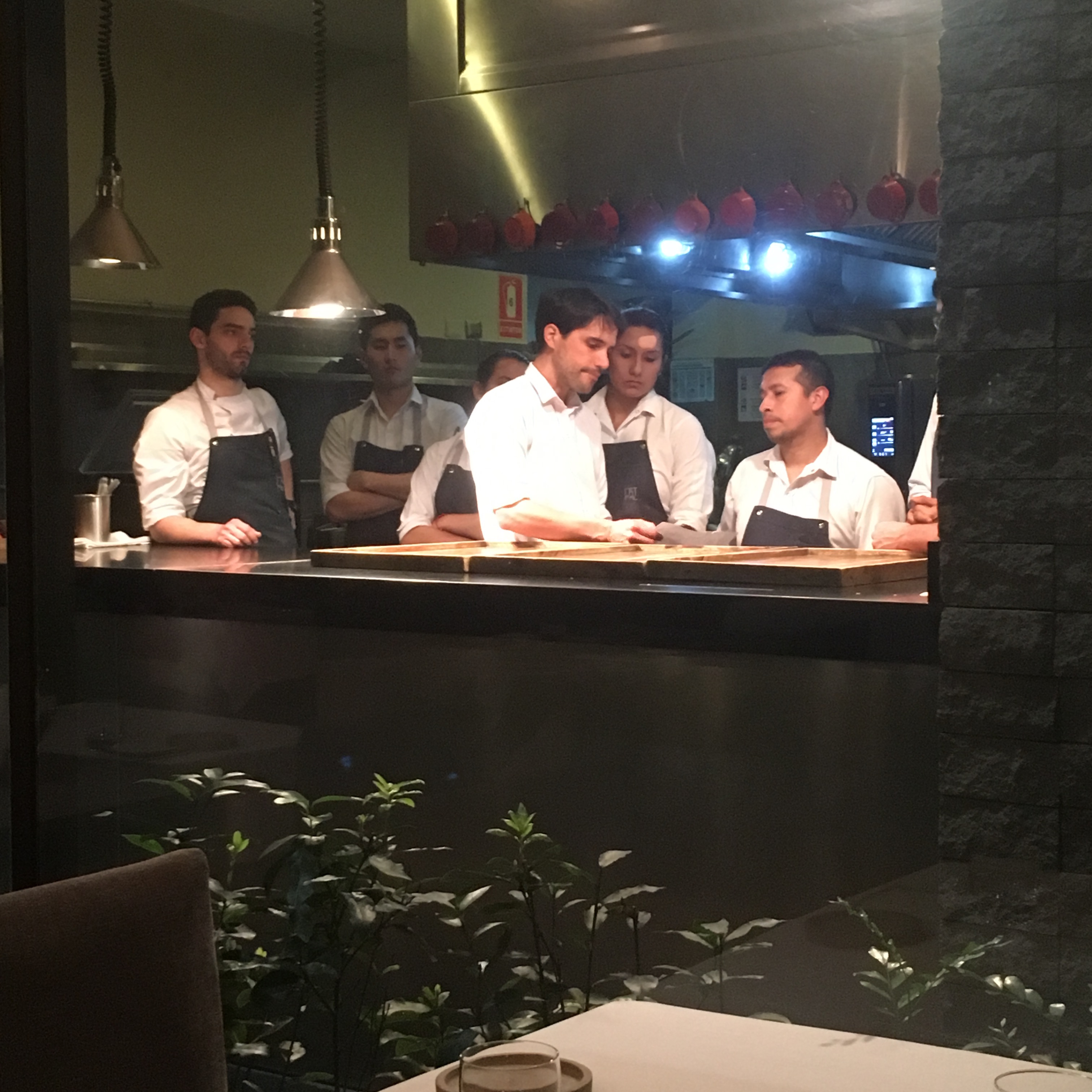
There are four menu options—13 or 18 courses, vegetarian or not—we went with the 18 course meat menu (obvio), with wine pairings. The menu organization is really fun—each dish includes ingredients from a different Peruvian ecosystem, which is defined by an elevation above or below sea level. It the deeply embraces the concept that “if it grows together, it goes together”, and celebrates one of the things that makes Peruvian food so thrilling—travel a few hundred miles and you can cross from ocean, to desert, to mountain, to jungle. While the dishes were not, with a few exceptions, traditional Peruvian dishes, the heart of the restaurant was the heart of Peru.
As best I can, I’m going to describe each dish from last night (not the wines, I don’t have the language to do them justice, but believe me they were perfectly selected. 7 whites, a malbec with the beef dish, a tumbo and pisco cocktail to start the meal, a local beer, brewed with quinoa, with the “extreme stem” dish, and a sherry to close out). The photos are sometimes blurry, and I might have forgotten an ingredient here or there, but this is a meal I never want to forget. Future Ben, if you’re reading this, remember that veal?! That lettuce?! Those gnocchi?! And present family and friends, if you’re reading this get ready to hear about veal! and lettuce! and gnocchi (and a lot of parenthetical descriptions of super cool ingredients)!
A dehydrated crab cracker (definitely similar to the shrimp crackers from Asian supermarkets), then a layer of limpet (an aquatic snail—a slightly chewy texture and a gentle seafood flavor), then a citrus cream, and topped with sargassum, the same seaweed that ubiquitously tops ceviche all over Lima. A perfect first bite to start the meal.
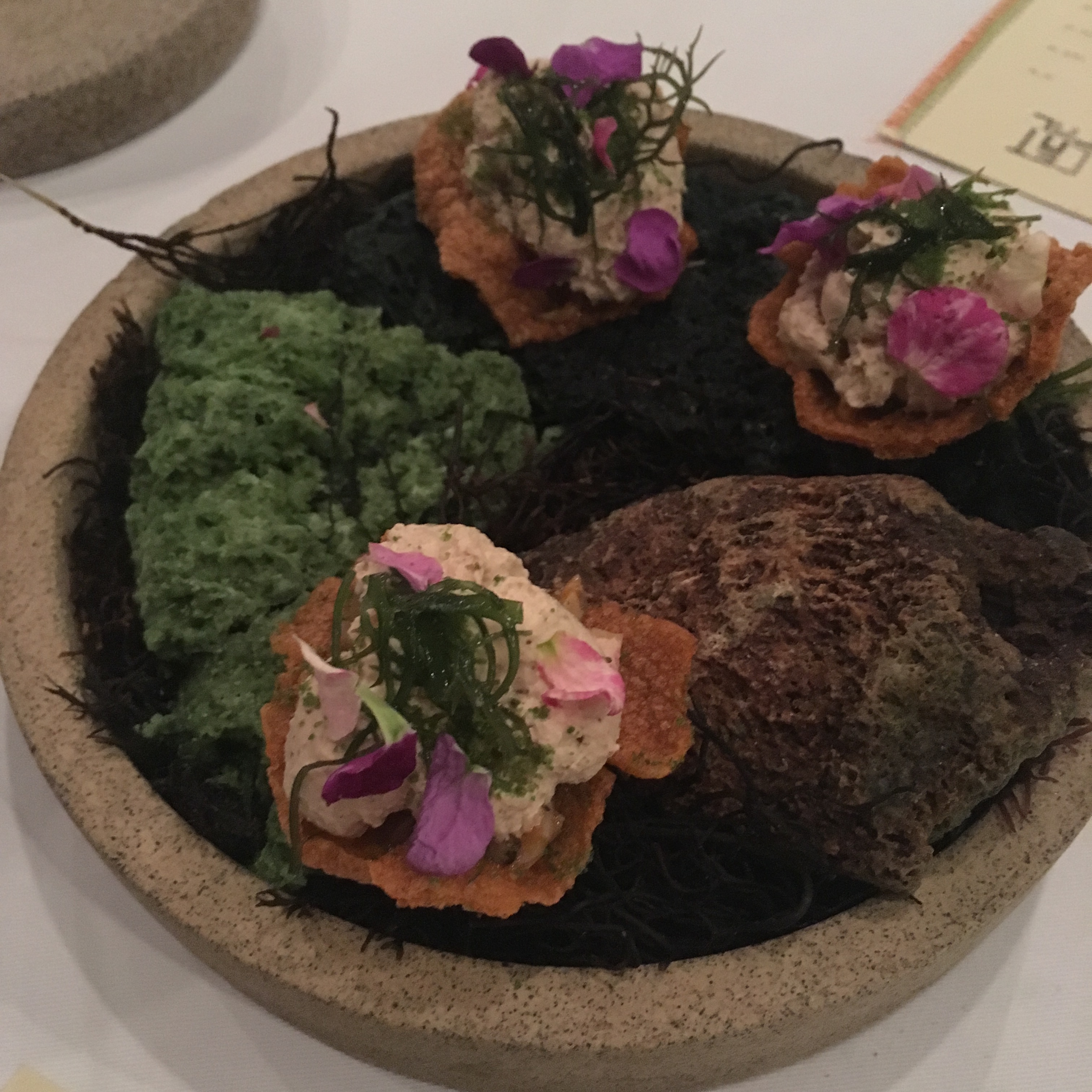
Natalie’s maybe allergic to crab (and lobster and scallops), so she got a shot of pacae (bean tree!) leche de tigre, with a little sandwich of sargassum ice cream between crackers made from a different seaweed. She loved it.
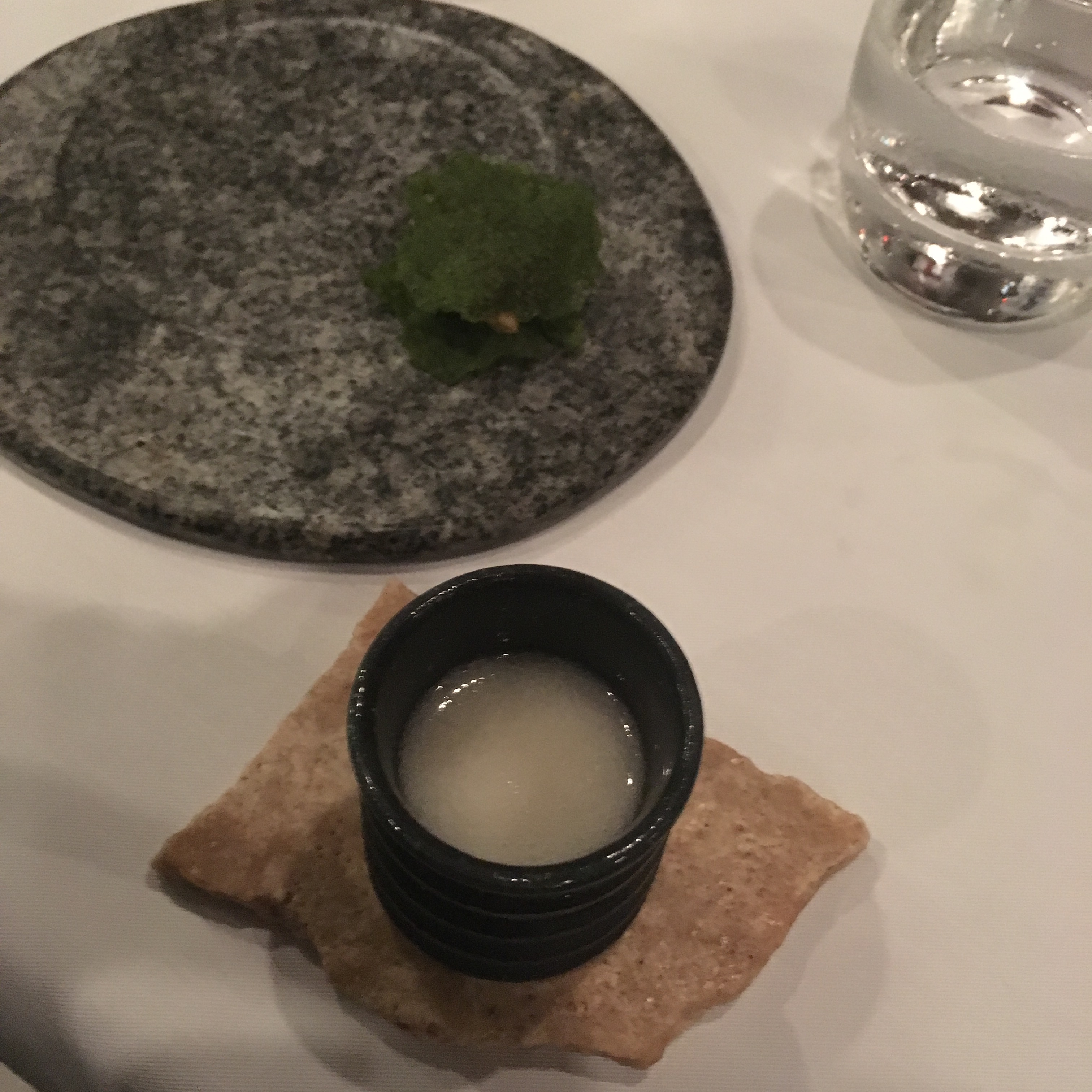
The next two bites were both built around a lucuma mousse (a creamy fruit, commonly used in ice cream and other deserts). It’s not normally a flavor with a lot of character, but it was perfectly highlighted (without being overpowered) by some other great components. First, there was an amazing cracker made from onion ash (super savory and a little bitter), then the mousse and some gorgeous little crisp and spicy flowers (many dishes had herb and flower garnishes, which came from the garden on the restaurant’s roof).

Next, a “bread” made from huarango wood (carob tree, most often used in Peru to make algarrobina, a syrup with a flavor between honey and molasses) which had a texture somewhere between cotton candy and mochi, and a nice earthy flavor. More mousse, coated in lucuma seeds (more a texture than a flavor, something like dried coconut). Like many of the single bite dishes, it was full of absolutely delightful textural contrasts.
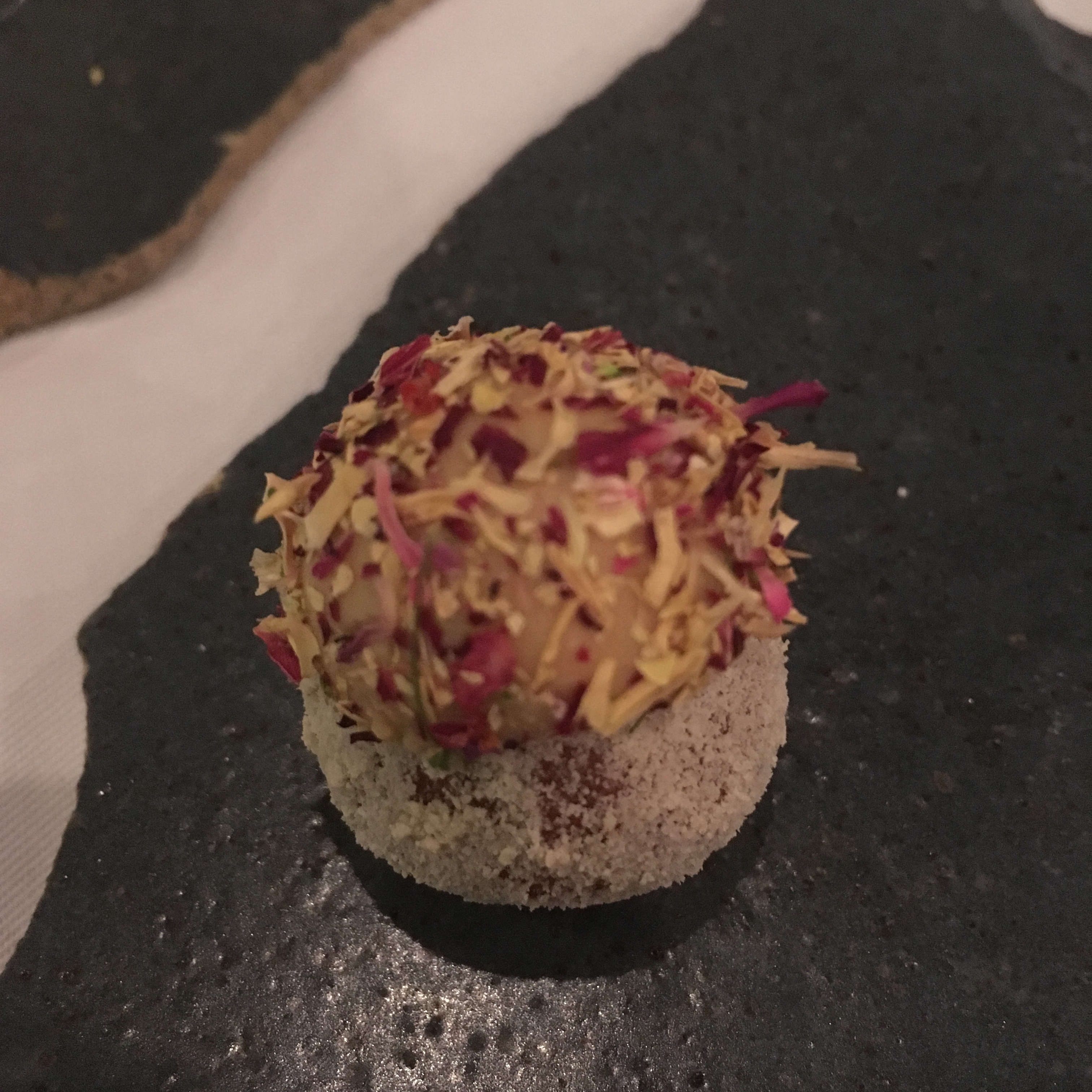
The beautiful little root in the picture below is huarango (the root of the carob tree—never cooked with it, but I see it every day in the market), which was thinly sliced and deep fried in a roll. Inside, there were two creamy sauces, one bright green (green looking and green tasting) of zapallo (I think it was zapallo italiano, which is a kind of zucchini), and another of Andean duck. Rich and green to start, with a tart and ducky finish. The beautifully diced salsa on top was red onion, chili, lime, and something green (more zukes?)

Three componenets to this course, all built around corn. First, a little cracker of dehydrated red corn, with pastes of yellow and purple corn (somewhere between a fudge and cornbread texture), and fried corn silk. Great textures, good flavors.
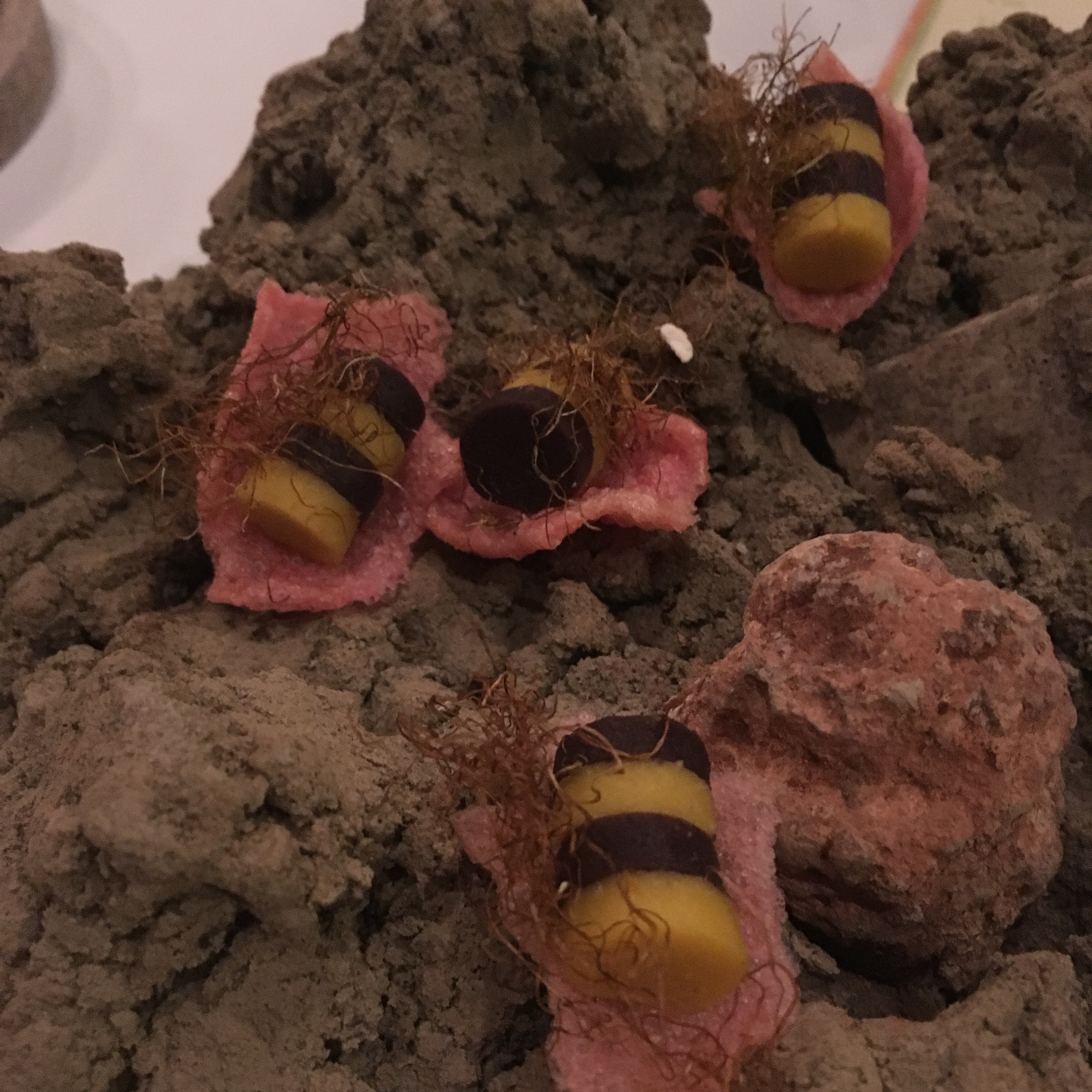
Next was a little cracker of corn, with cracked dried corn and honey (super reminiscent of a cornflake) with an absolutely astoundingly delicious drink they called “corn milk” with tumbo. Pureed yellow corn with tumbo juice, thick and creamy, sweet and sour, absolutely intoxicating.

Yacon is the root of a daisy, which our waiter told us normally tastes a bit like yuca, but sweeter. It was smoked over the wood which it’s served on (those gorgeous little curly things). And, travesty of travesties, I forget what the yellow sauce was. But it was crisp like a water chestnut, with a little smokey finish that took away some of the sweetness, and juicy as a cucumber. Straight up fun to eat.
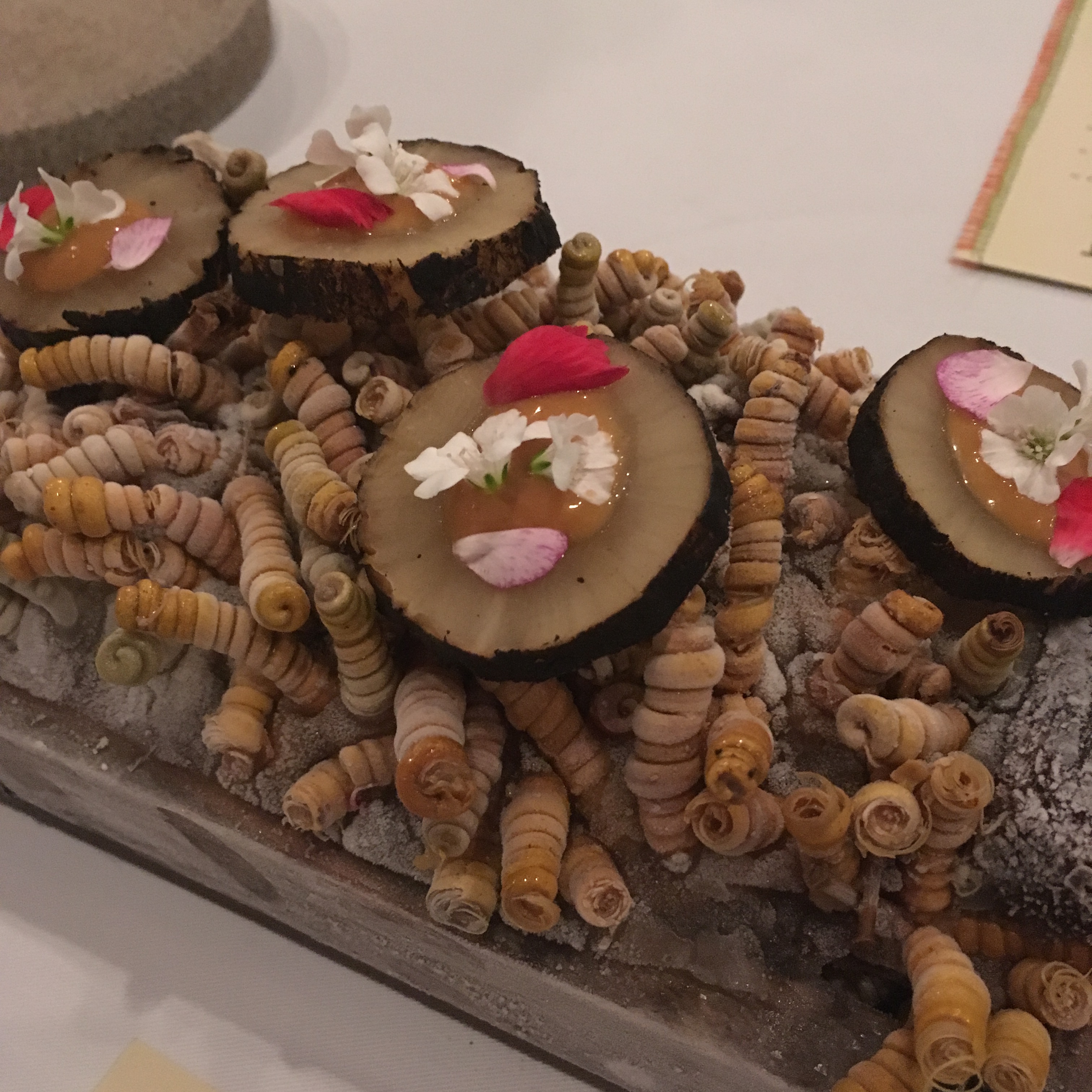
A gorgeous dish, without a whole ton of flavor. But beautiful to look at, and nice textures. It was a black chia seed cracker, with a cream of snails (shellfishy) and sangre de arbol (a red tree sap, I’m sure there was a flavor but I think mainly there for the color), with shredded flower petals.
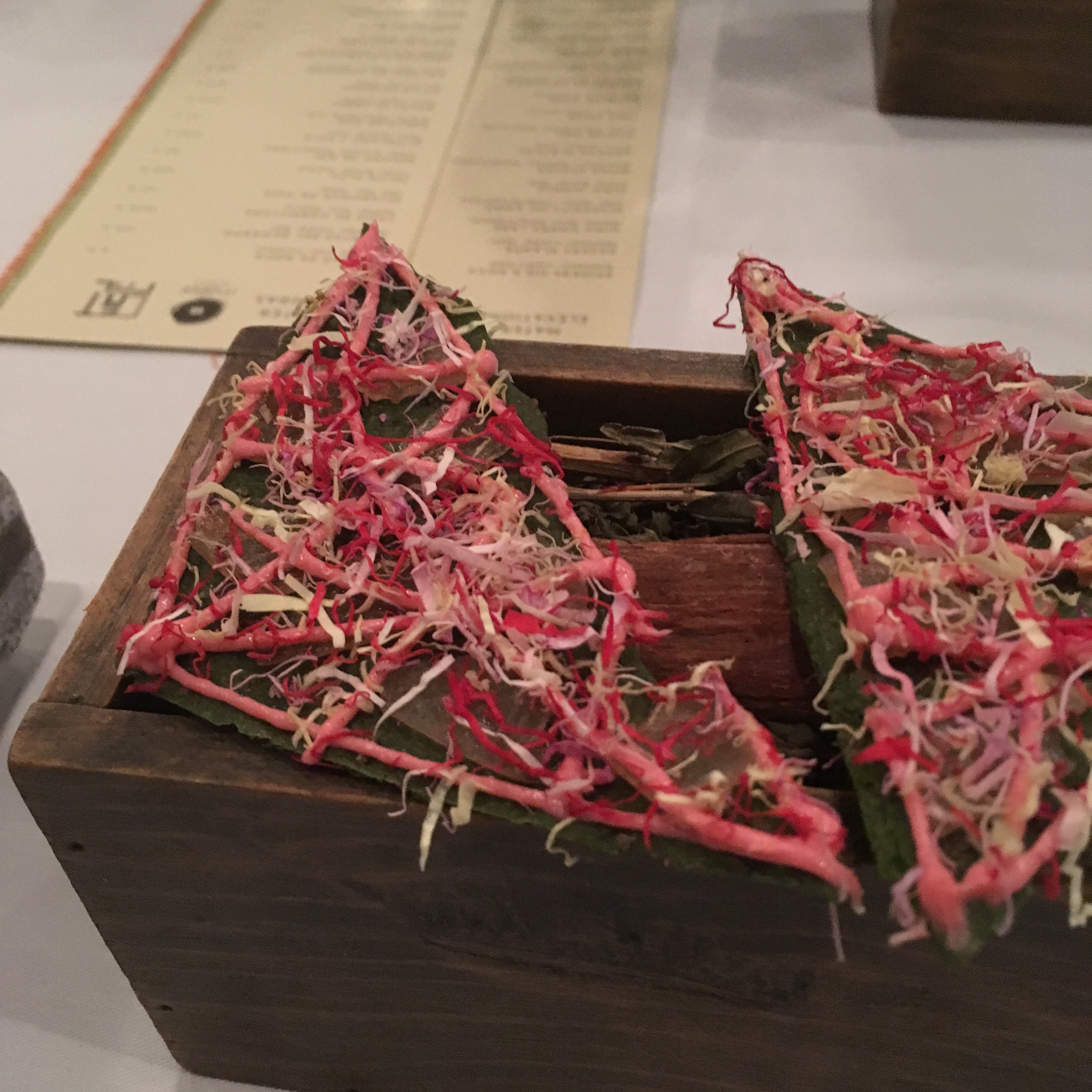
Natalie got a similar cracker, with a puree and some fried bits both made from a palm tree (palm trees, a variety of different species of them, were all over the menu).
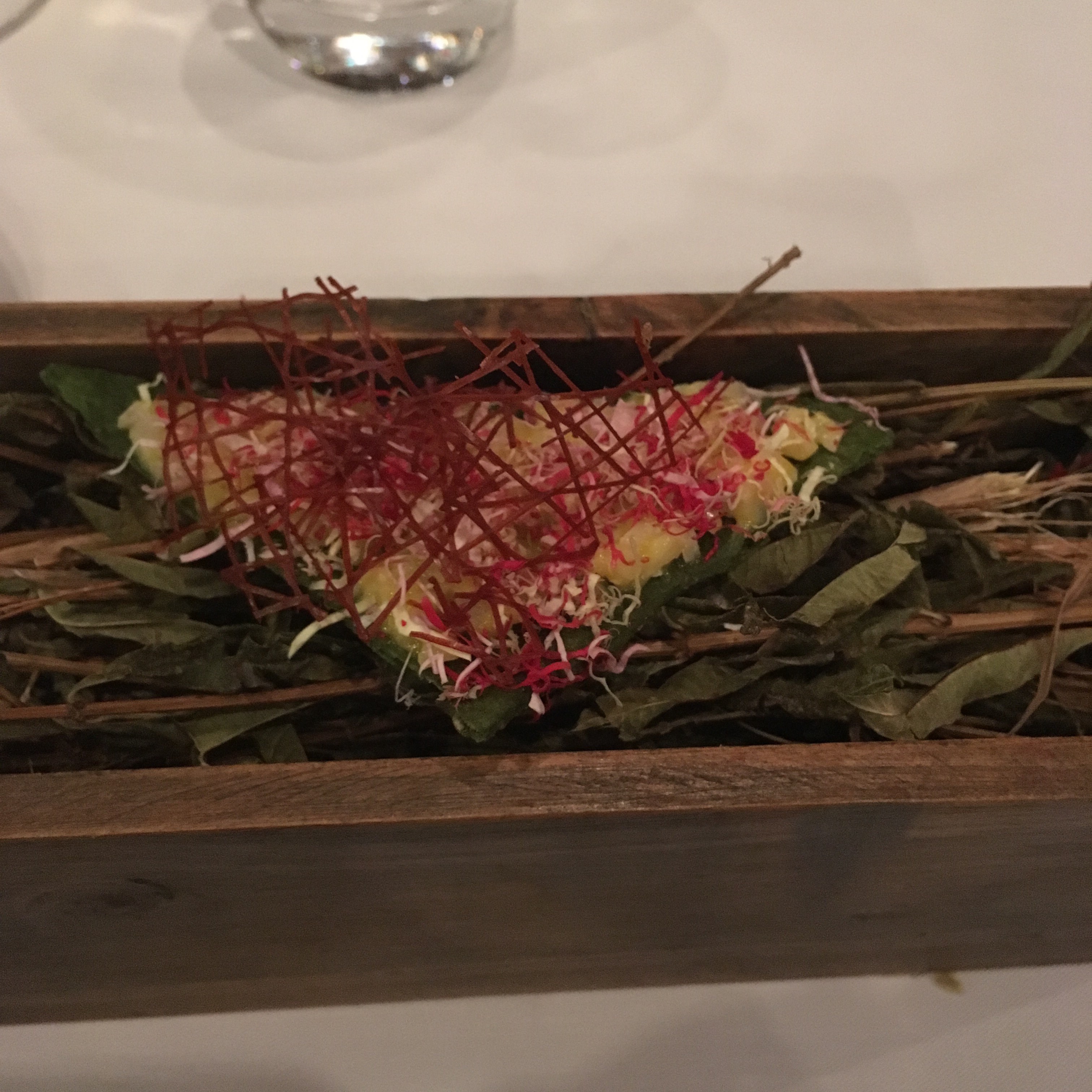
Oh wow. This course. It was a bread course, but it was so much more than that. A cracker made from tunta (naturally freeze dried potatoes, left out on the tundra to be preserved) dusted with chili and coffee.
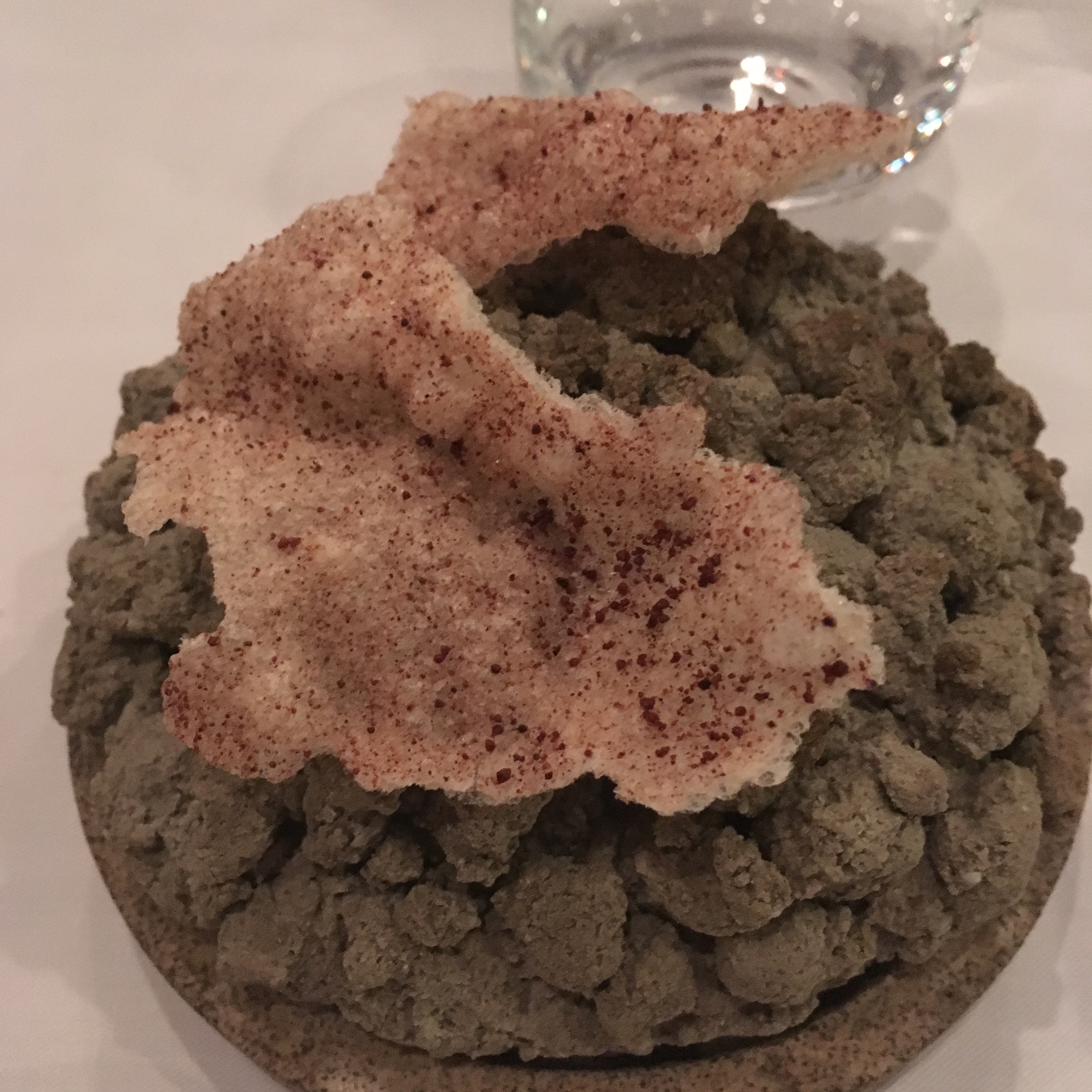
Then “corn bread” but the only ingredient was corn (fresh and dried). I have no idea how they made it, some black magic, but wow was that flavor intense. Warm and toasty and just pure corn.
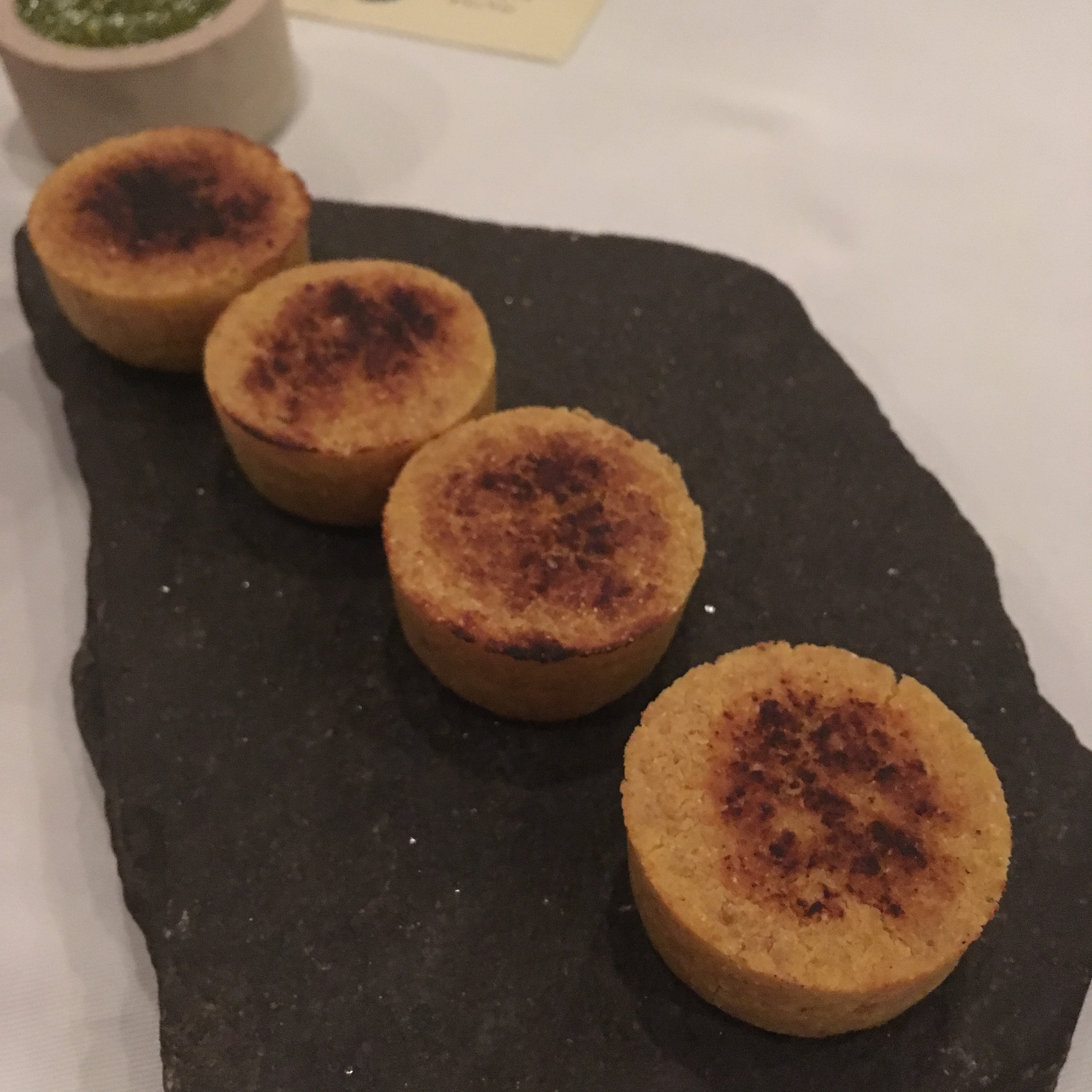
And a roll made with annato (aka achiote) seeds, set over smoking coca leaves after it was pulled from the oven. A really intensely delicious smoky flavor got into the bread. Seriously great.
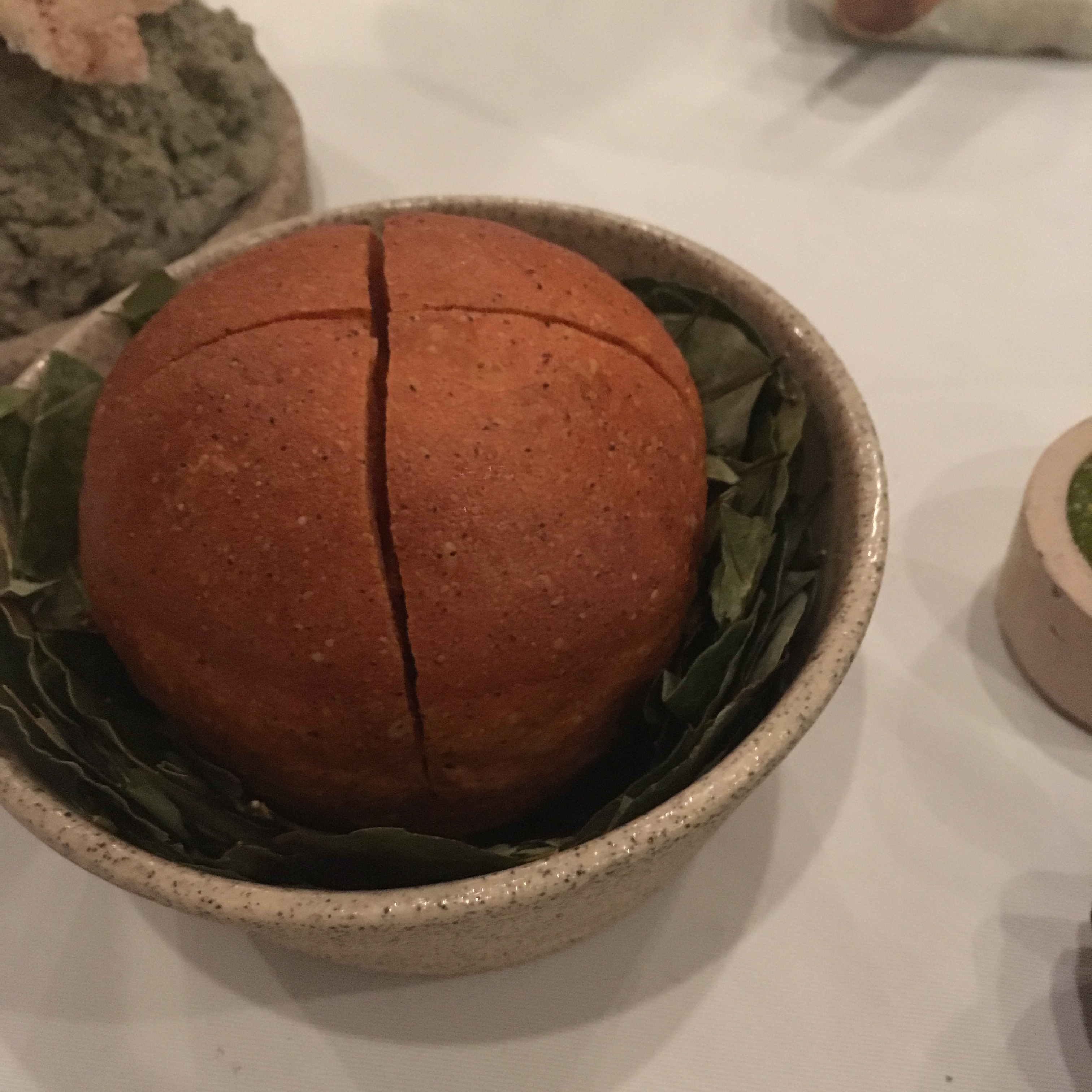
And for spreads, there was a little dish of solidified brown butter (I could eat it by the spoonful), which was absolutely stellar on all three breads, but especially the warm cornbread.
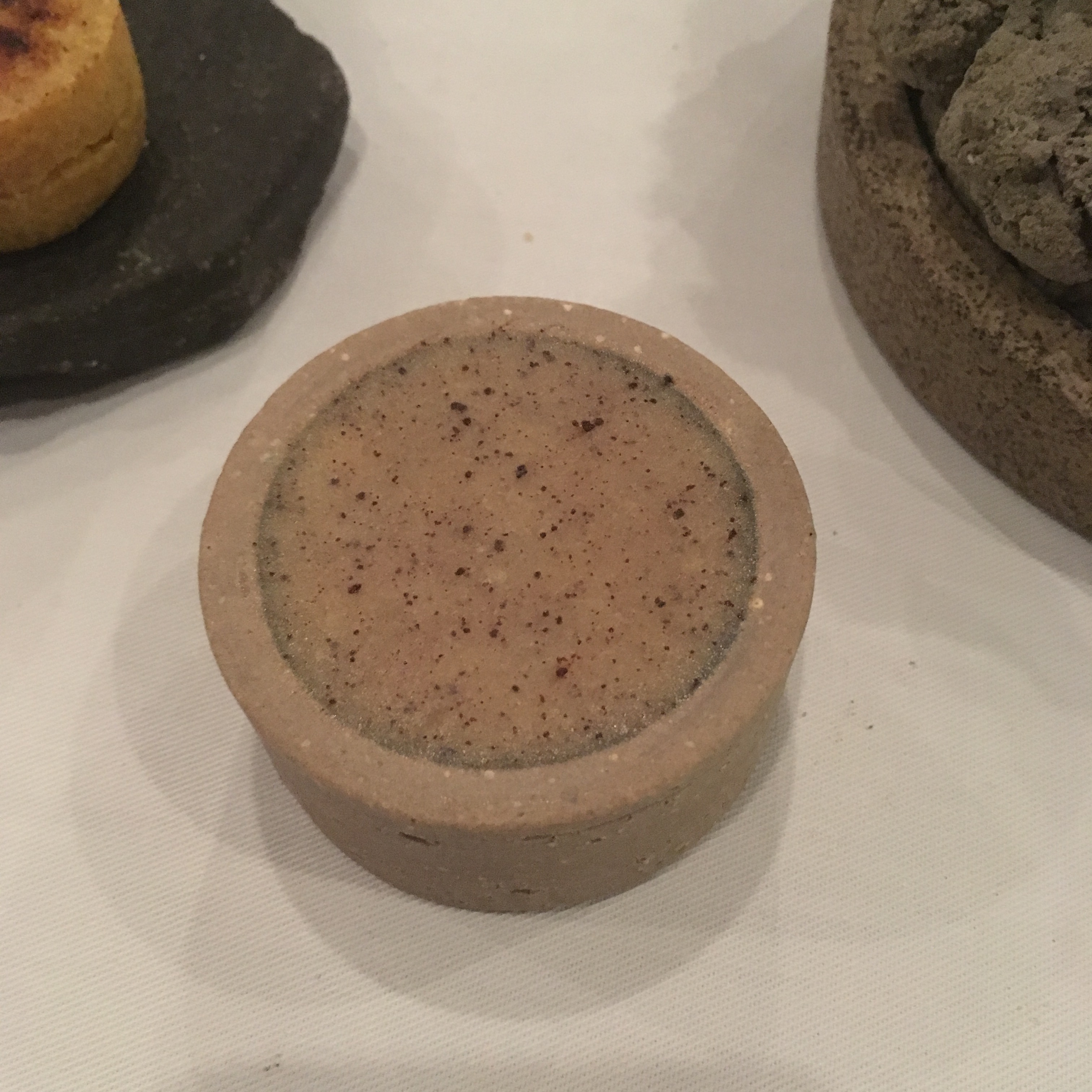
And a spread made from a little queso fresco, a little pancha chili, and Andean herbs—huacatay and muña, both of which are minty but a bit more bitter and savory (like tarragon), plus cilantro. So super awesome tasty great.
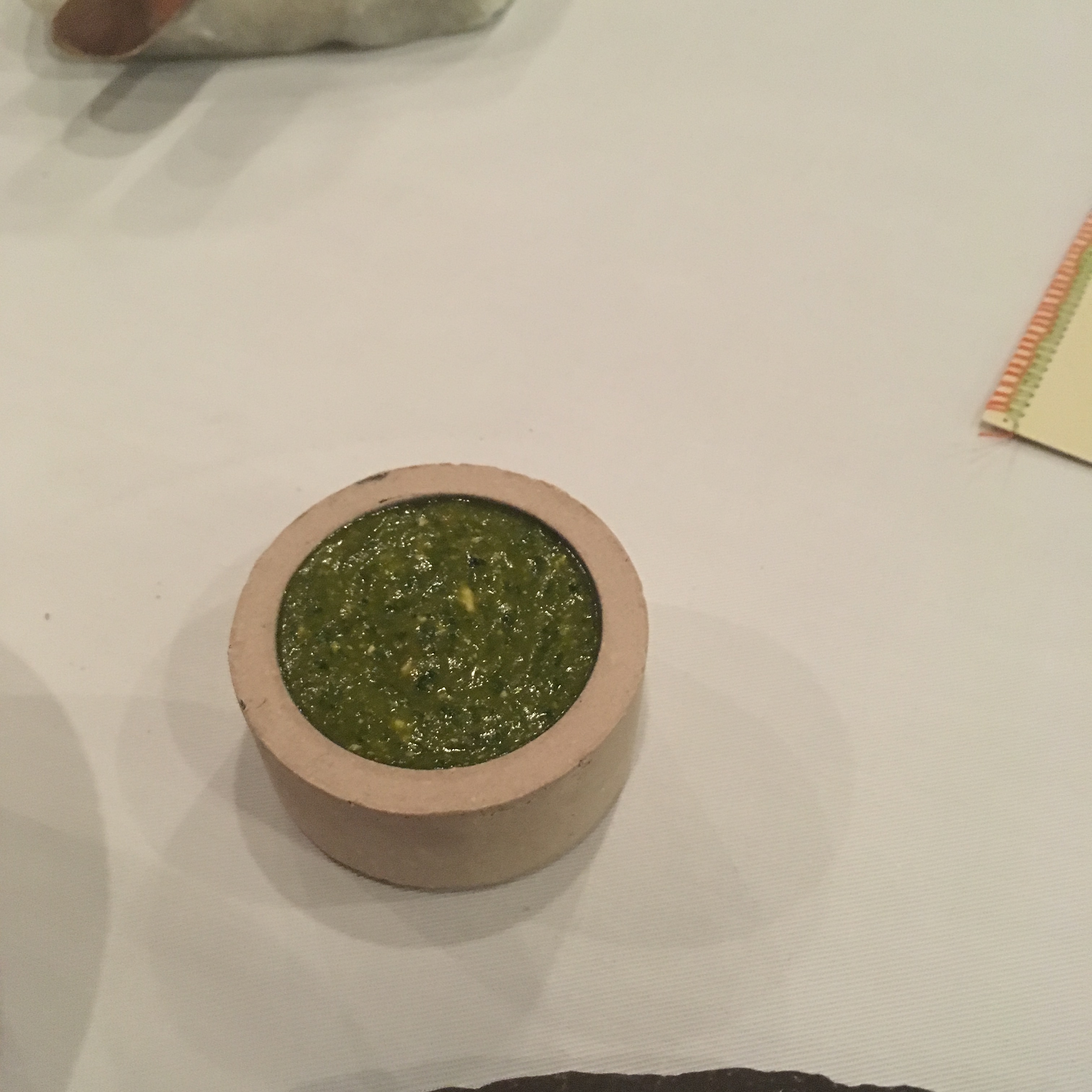
Besides the knives for the spreads in the previous course, this was the first course we ate with silverware. The middle third of the menu (starting with this course) were slightly bigger “main” courses. On top of this dish, there were slices of pepino, a wonderful melon (even though they were so thin, the slices were bursting with juicy flavor), then a cream of “sweet lemon”, which I think is pretty close to what we’d call a lemon (“limon” in Peru refers almost universally to Peruvian limes, tiny and super tart), and big chunks of lemon cured clam (the texture was closer to a scallop ceviche than anything, tender and not too chewy). On top there were gorgeous little borage flowers, shaped like stars. Intoxicating.
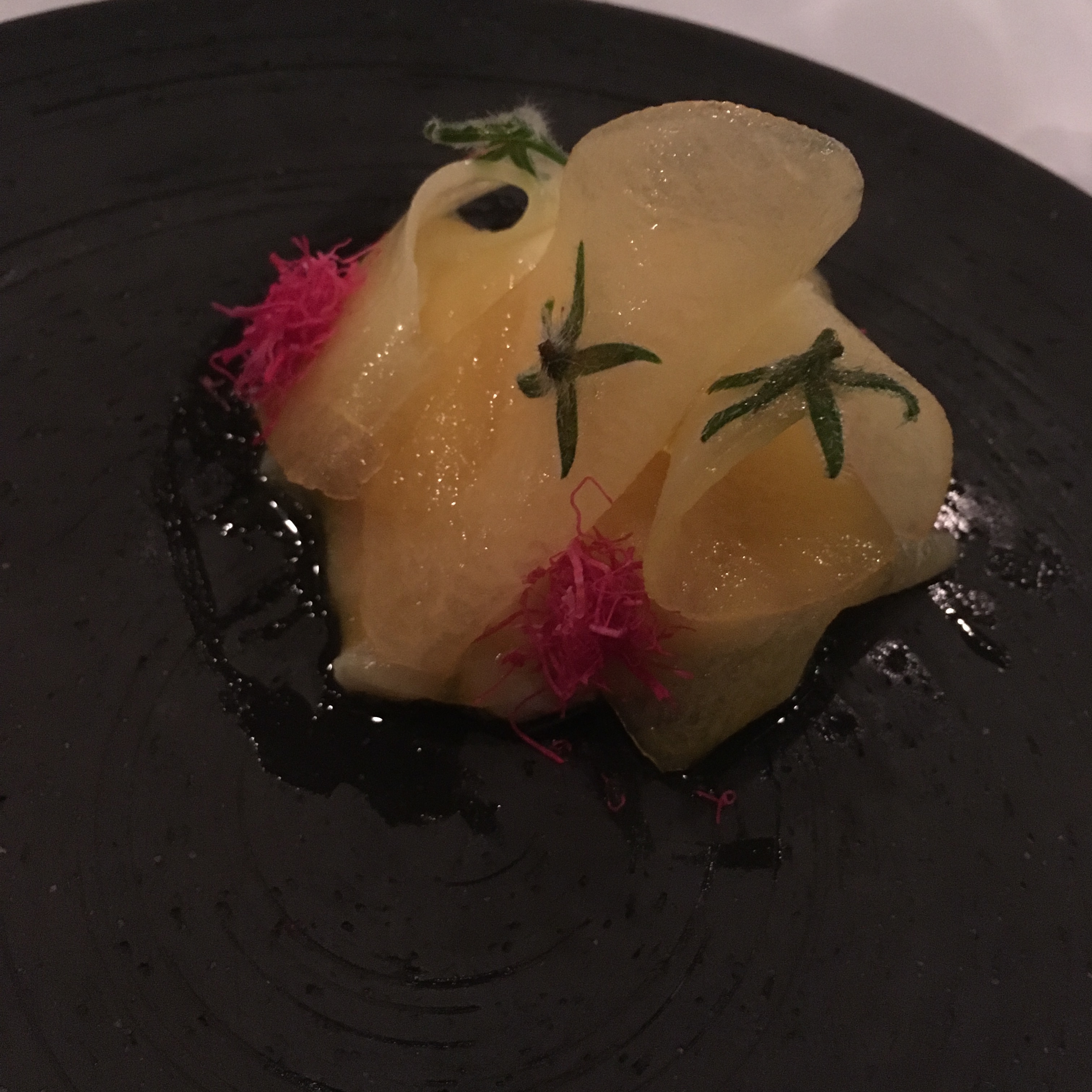
Turns out, when it’s at Central, a warm avocado salad is as satisfying as a steak. Unbelievably hearty course. Chunks of warm avocado, with two sauces, a dark green one made from butter, avocado leaf, and avocado skin, plus a yellow sauce made with loche squash and sour yellow tomatoes. The yellow sauce was also mixed in with little bits of kiwicha (amaranth), and then the whole dish was covered in paper thin, crispy slices made with seaweed and beans. Classic combinations, right? May be hard to imagine, but it was fantastic.
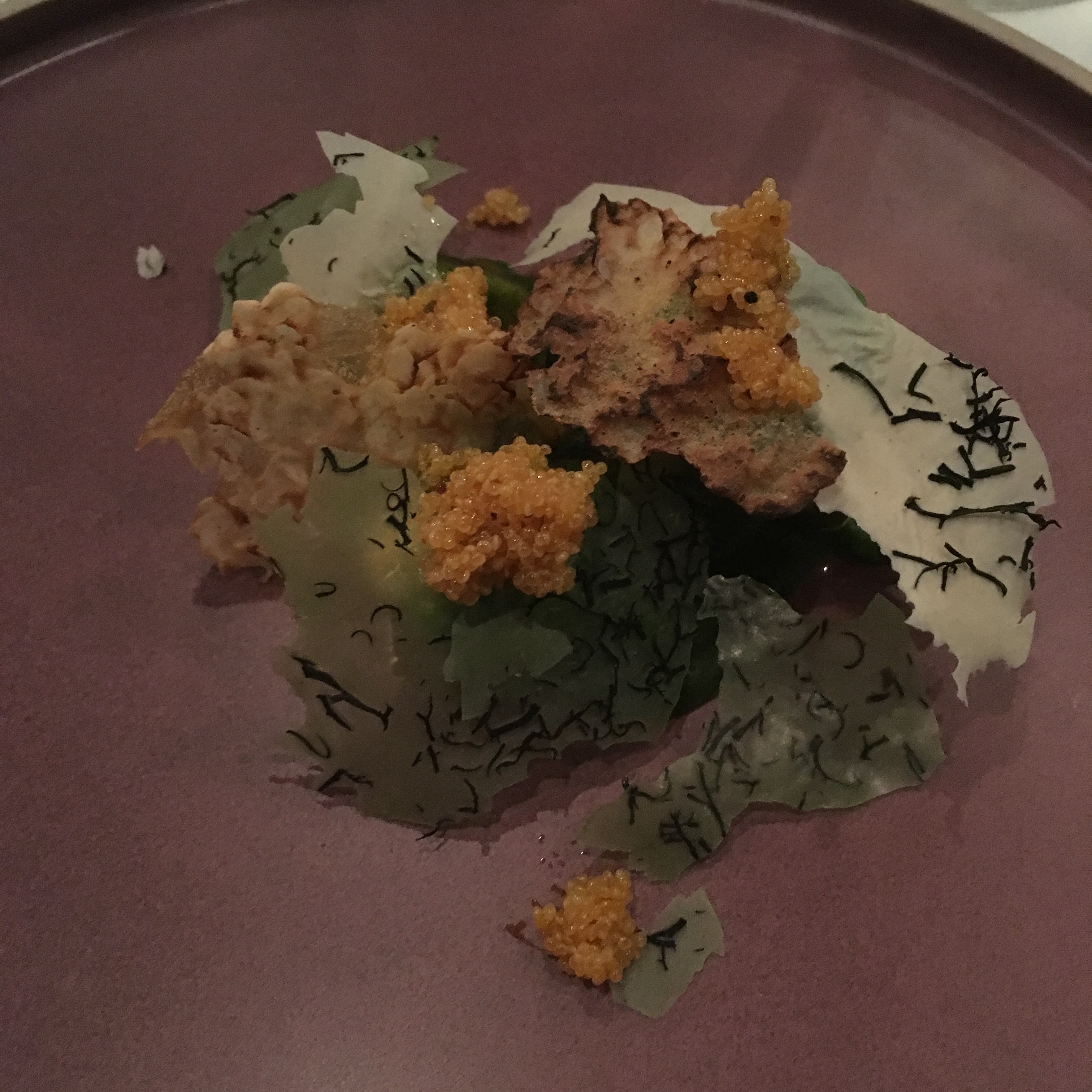
This course really exemplified how exciting this restaurant was. The crispy slices were made from three Andean tubers, oca, olluco, and mashua. A variety of flavors and textures, then married together with a sweet and rich and powerful sauce of elderberries. And the best part, all three roots were combined together into these intensely flavorful and rich dumplings, something like gnocchi (a little bit gummier, in a good way). It was a dish all at once totaly novel, yet somehow comforting and familiar. Magical.
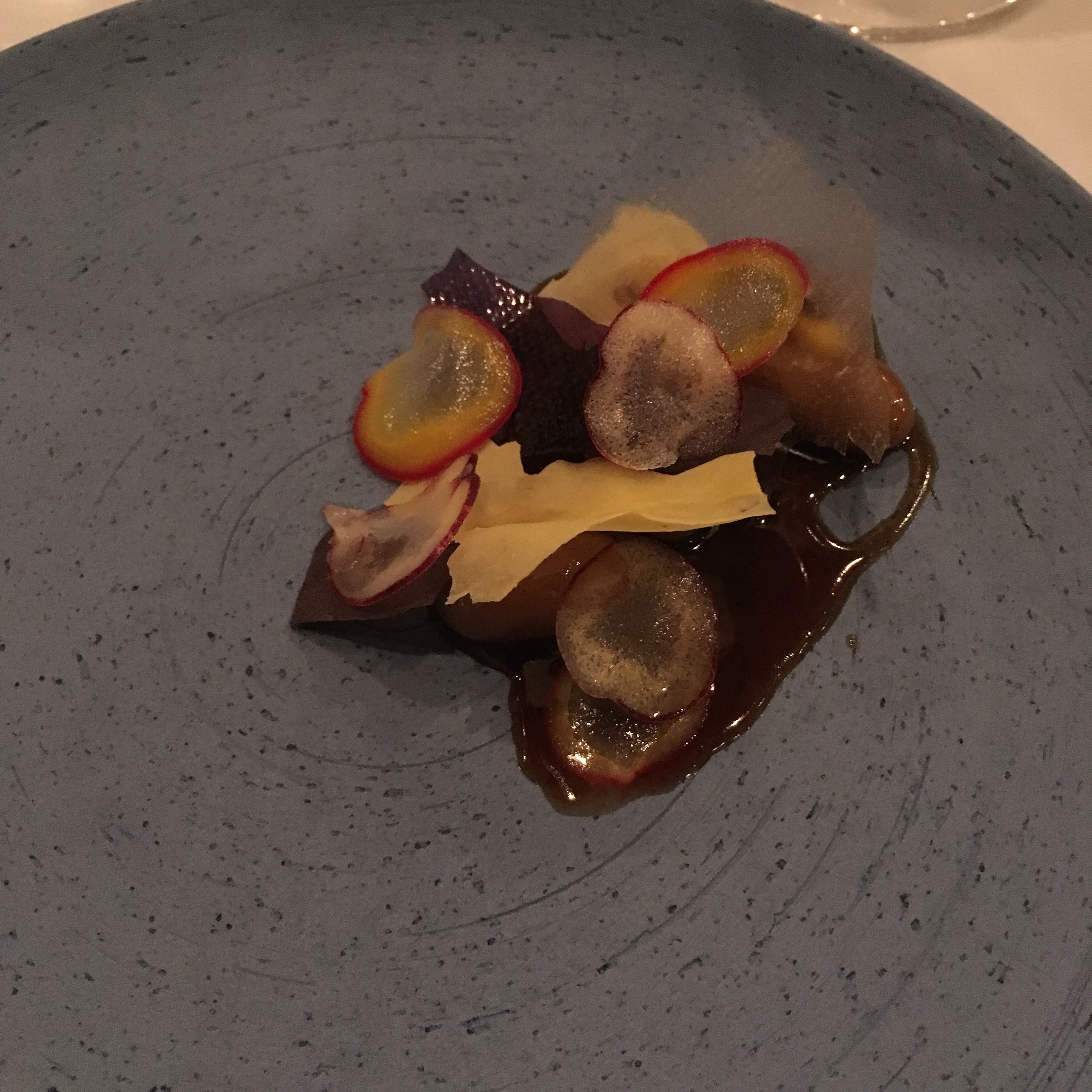
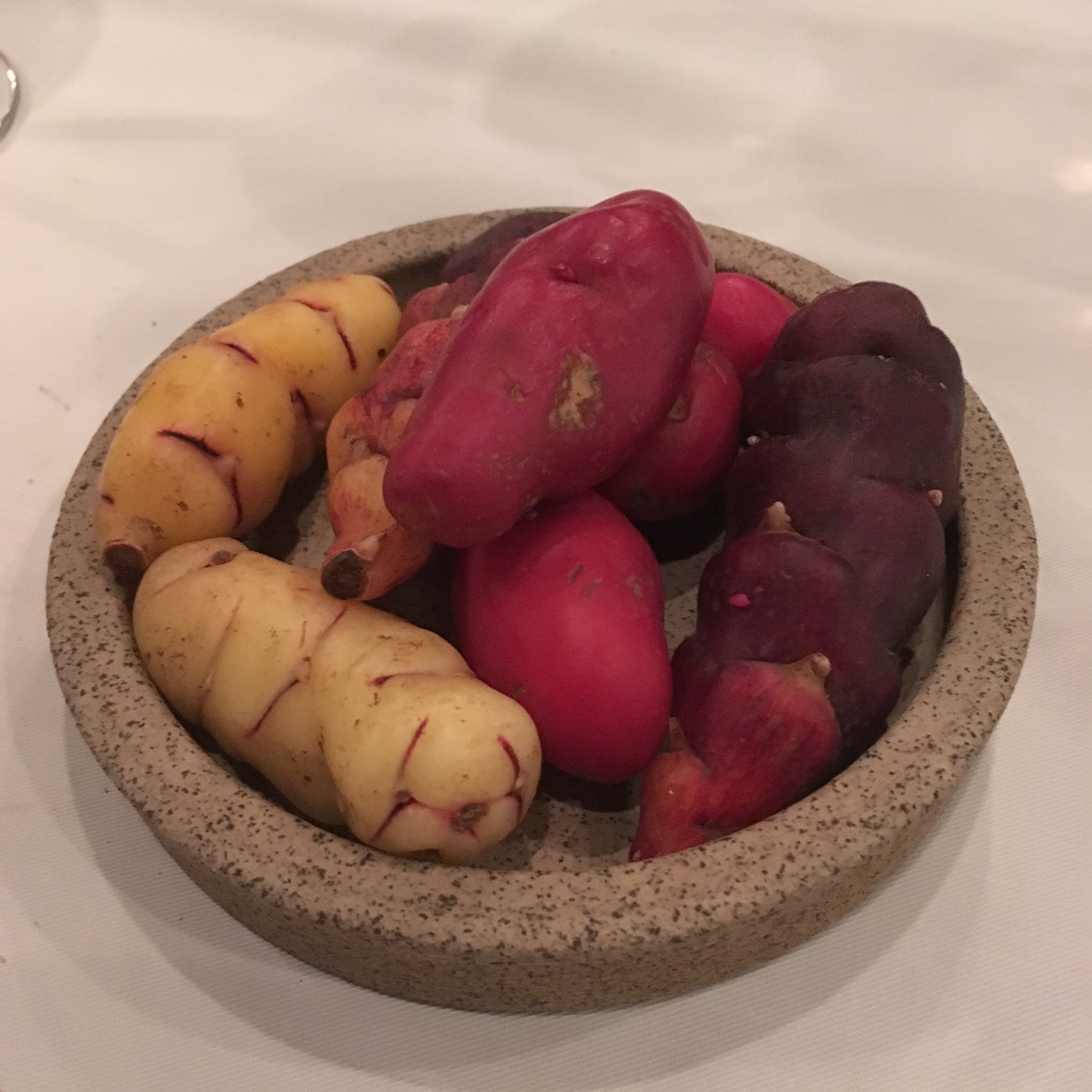
Thin slices of paiche (an amazon river fish), crispy slices of pijuayo (a palm fruit), a seafood infused, tart cream made with ungurahui (another palm fruit) and cocona (a fruit with a flavor between lemon and tomato). While it was fruity, citrusy, and full of fresh seafood flavor, it was also deliciously rich (a clean richness, from cream, I think).
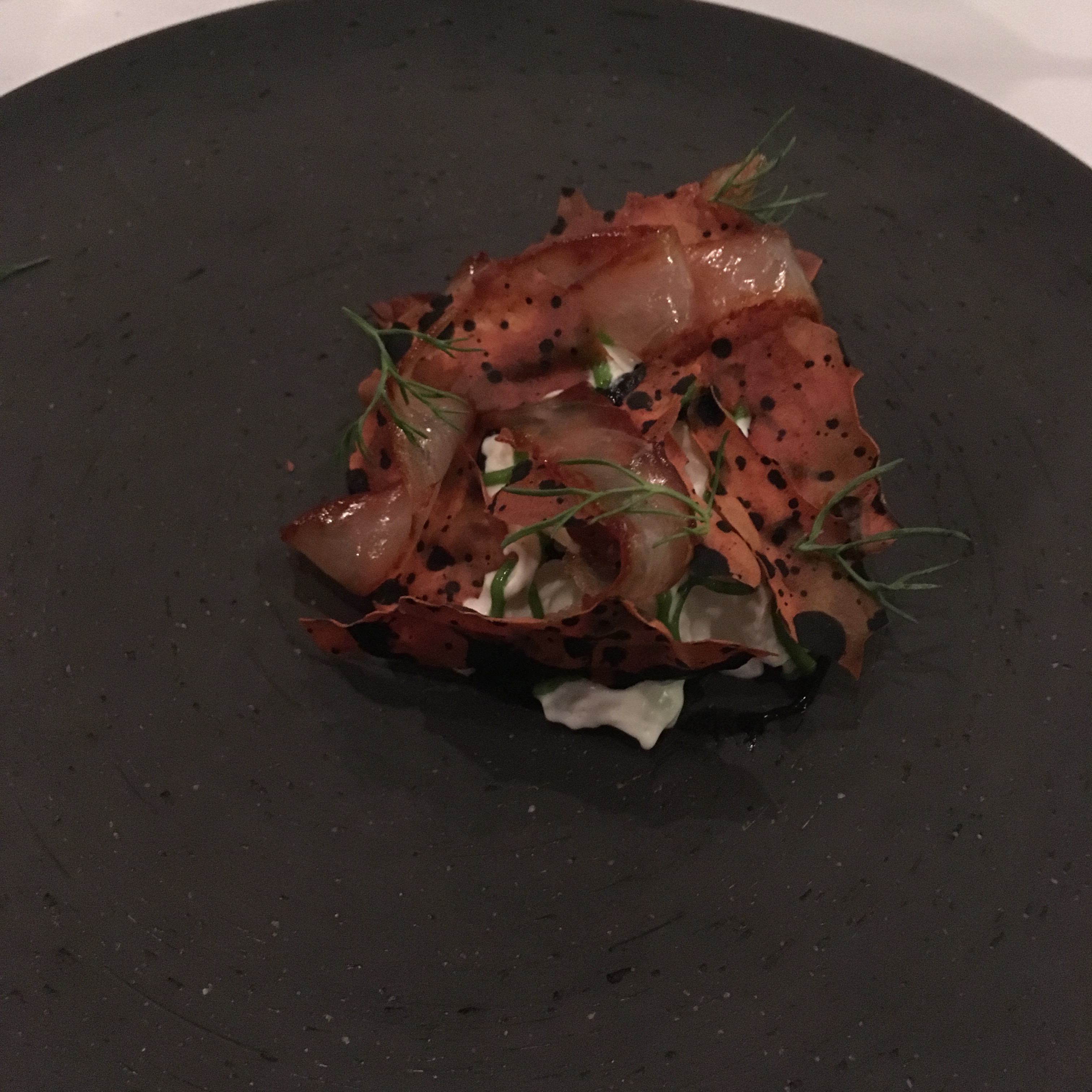
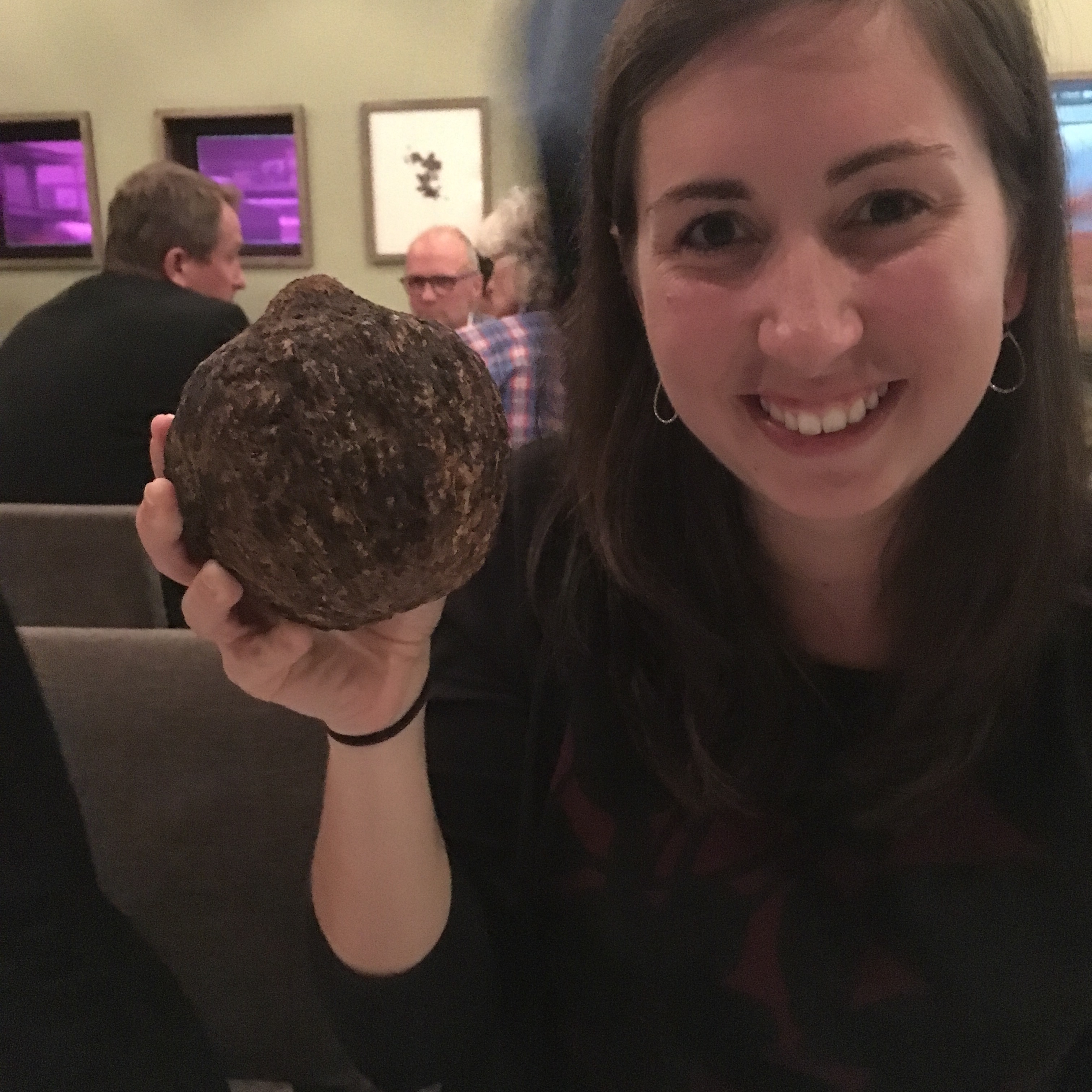
Mounds of sweet, succulent scallops, gently cooked or maybe lightly cured, not messed around with. On top, there was a net of fried sweet potato and crunchy sweet potato leaves (that shattered, without being dry or chewy), then underneath there was an absolutely stupendous braised lettuce, something similar to Romain (the waiter called it “lechuga nueva” when I asked (I asked a loooot of questions…)). The cores were still crisp, with succulent tender leaves. There was a small pool of the braising liquid set into a lovely circular indentation on the plate—scallop jus, ají amarillo, and sweet potato juice.
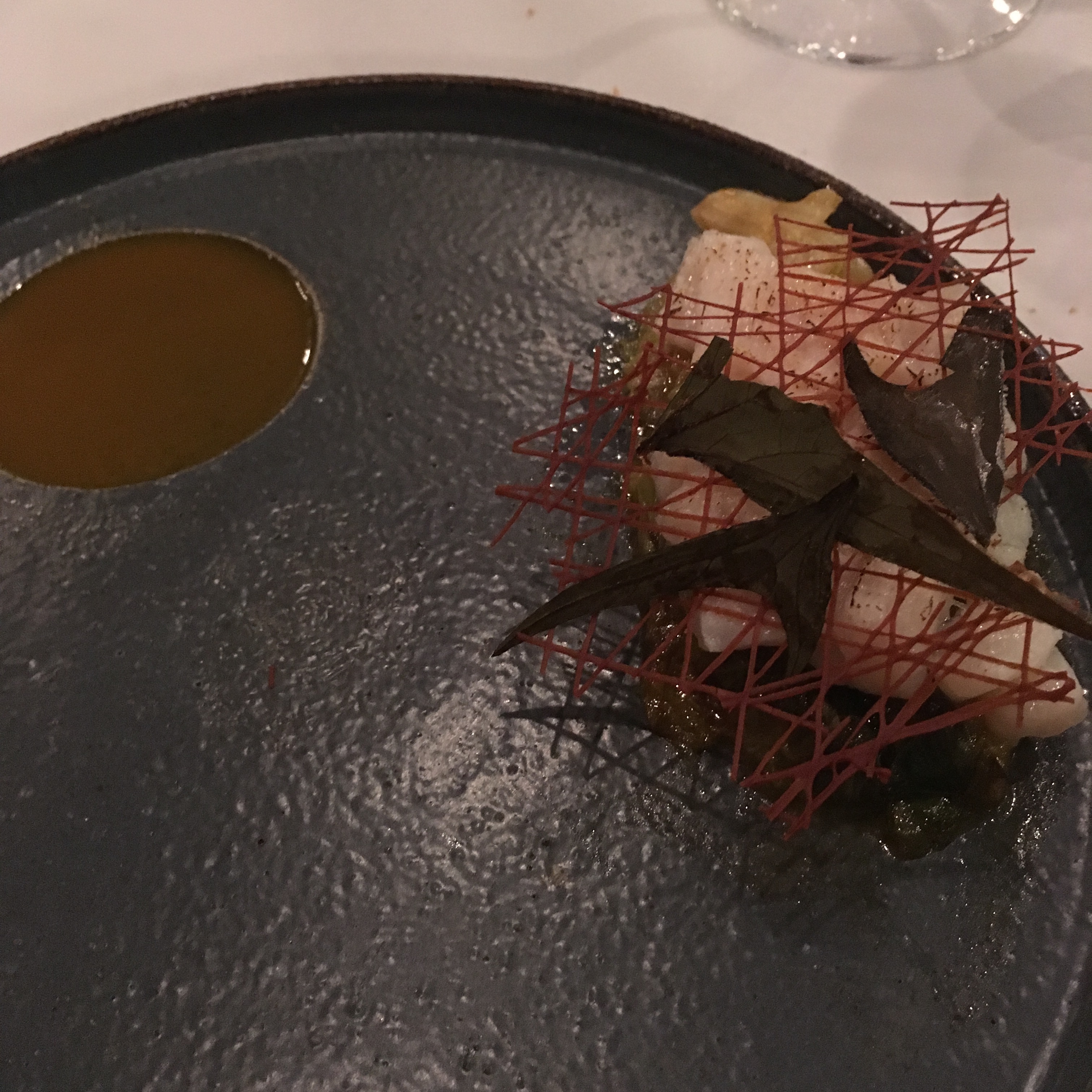
Nat couldn’t have scallops, so she got a hot soup of super tart sweet potato “consomme” with more braised lettuce. A totally different flavor than our sauce, acidic and warming. It stayed hot because it was served in a stone mortar. NEAT!
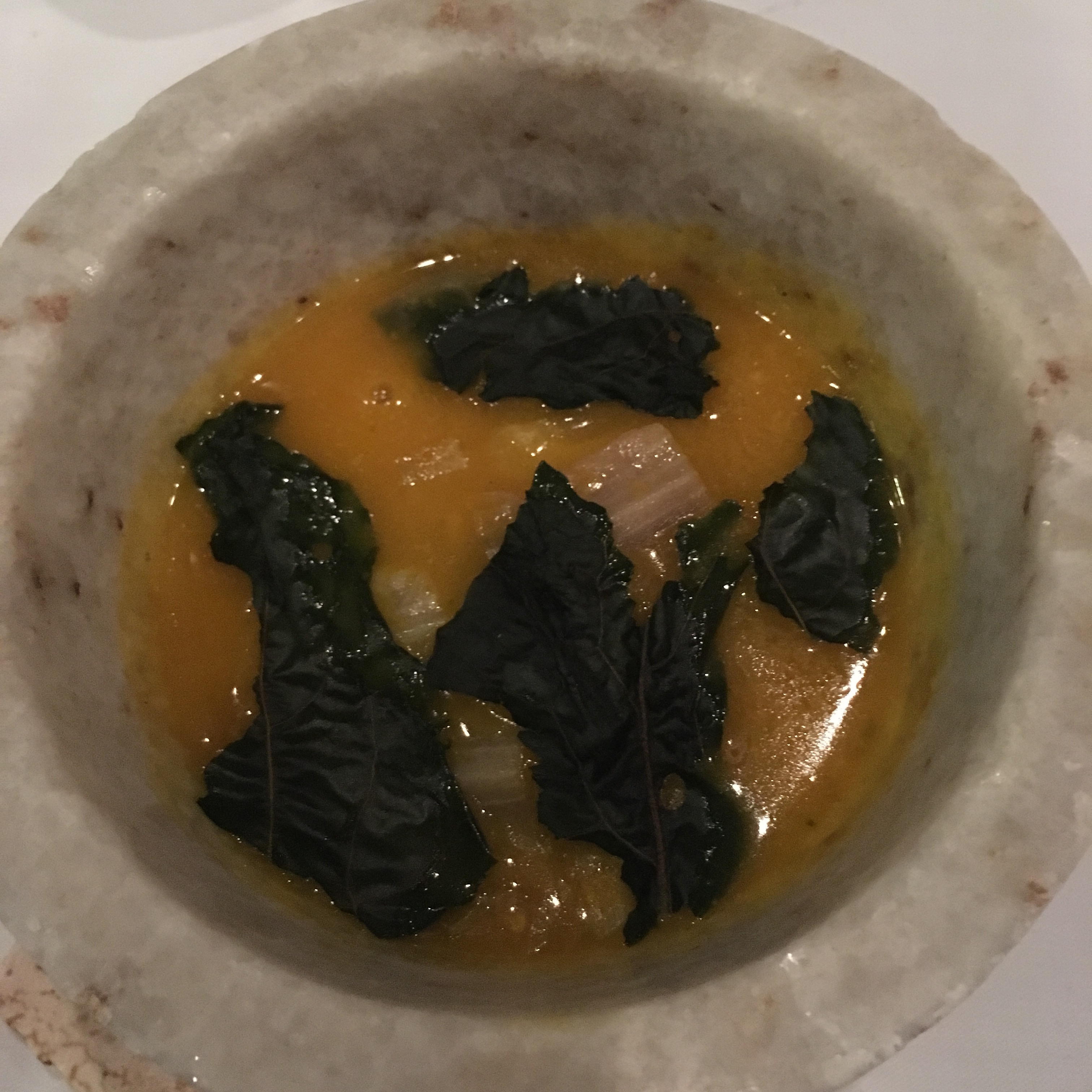
Octopus (pulpo) is one of Nat and my favorite Peruvian ingredients. And we certainly haven’t had better pulpo than we had last night. Big chunks of tender octopus were buried under thin crackers of dried shrimp and crab (just shrimp for Nat), bathed in a rich and creamy puree of garlic and potato. There was also young coral (not quite sure what that entailed, or how it was sustainable, but we trust that it was) dusted on the crackers.
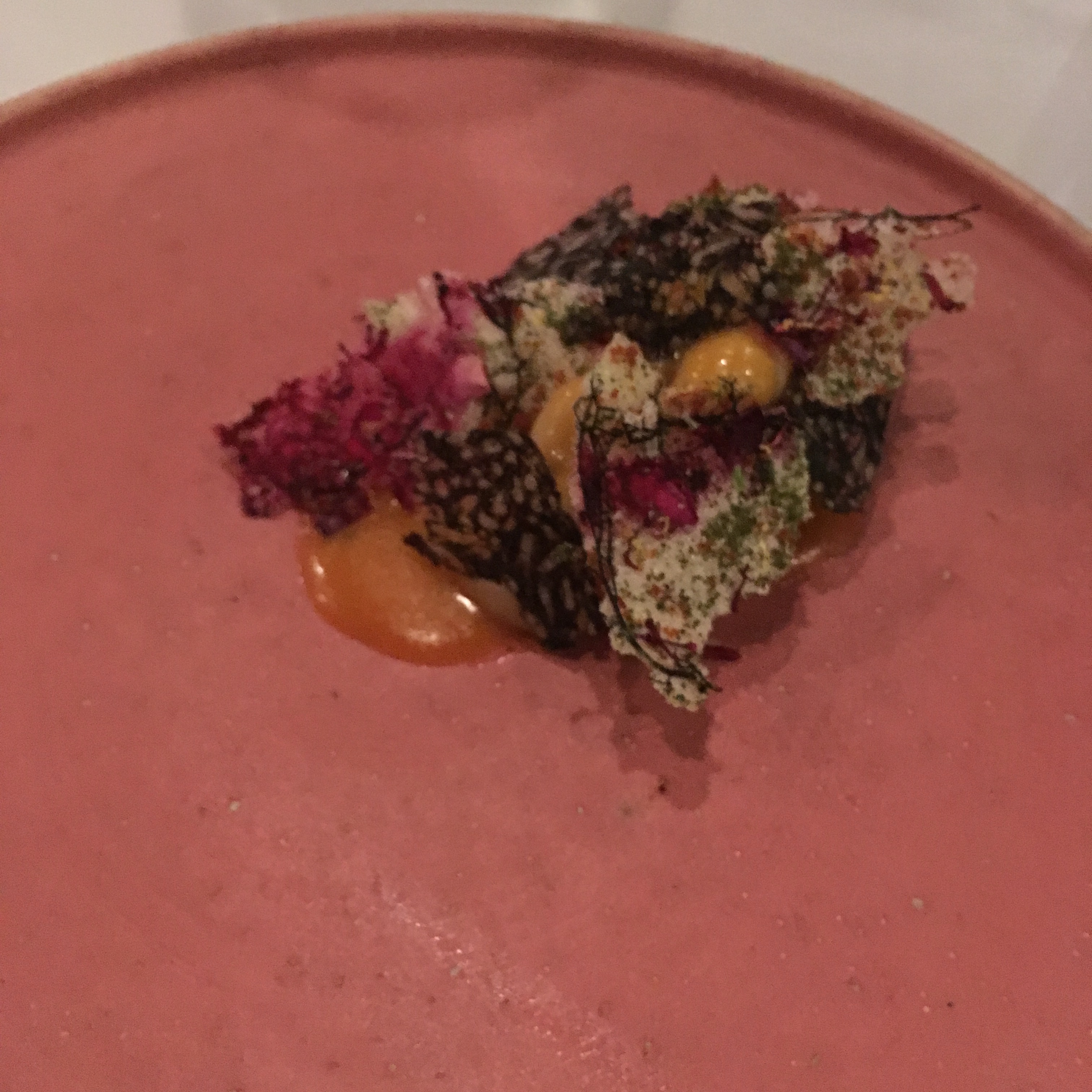
Before we ate the dish, we were given a piping hot shot of octopus broth, very similar to the broth (caldo) cevicherias serve as a first course. There was citrus and garlic and chili in there, too.
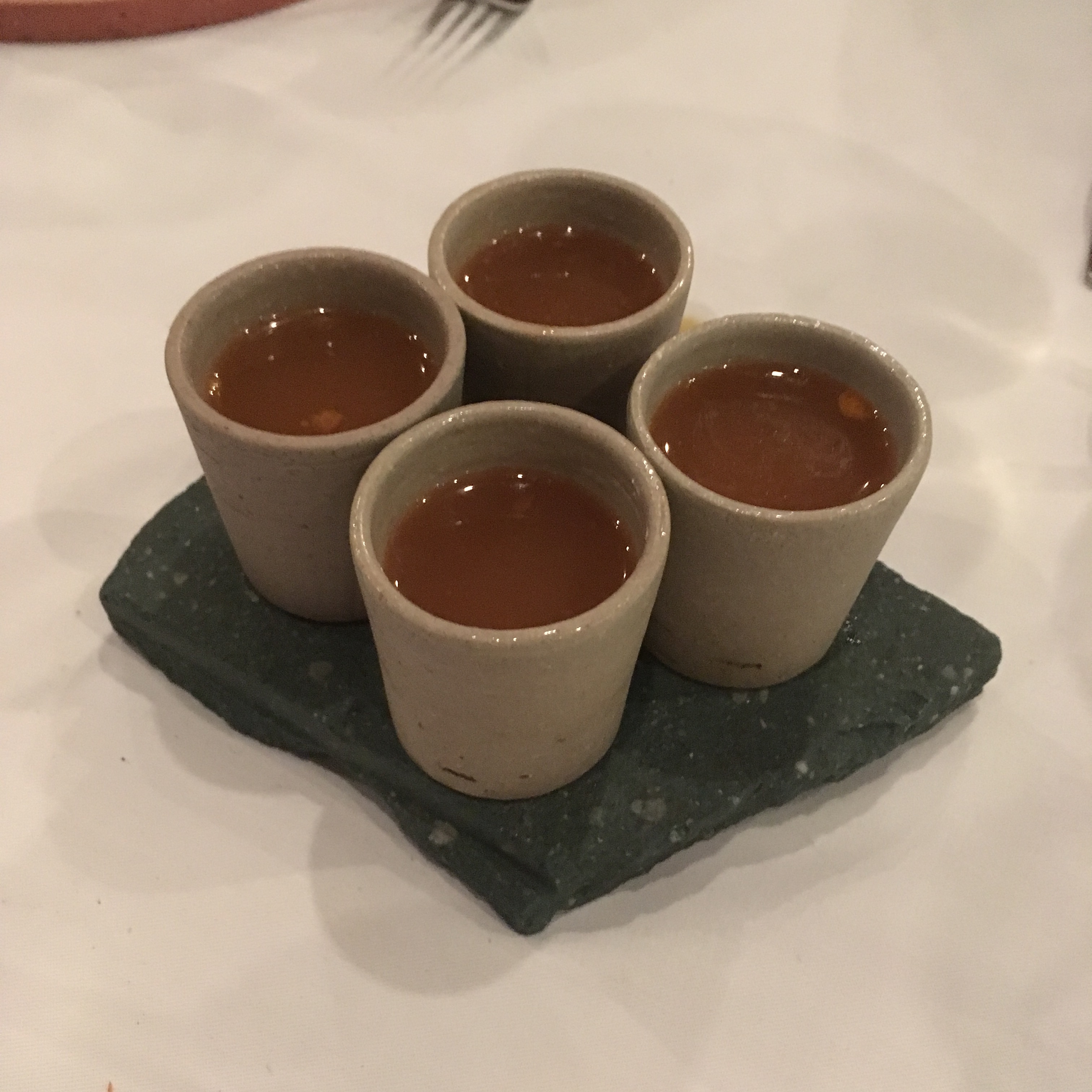
The last savory course was just the savoriest. Chunks of veal short rib, braised for 24 hours (braised in a very French way, red wine, veggies, herbs), served with three colors of quinoa. The black was natural, then the red was dyed with airampo (a cactus fruit that contributed more color than flavor) and the green with the same herb mix used in the spread in the bread course (huacatay, muña, cilantro), whose flavor came through at the end of each bite. And even more intense beef flavor was infused into the dish by shavings of dehydrated beef heart. The waiter poured on a little bit of creamy quinoa milk, and encouraged us to mix everything together.
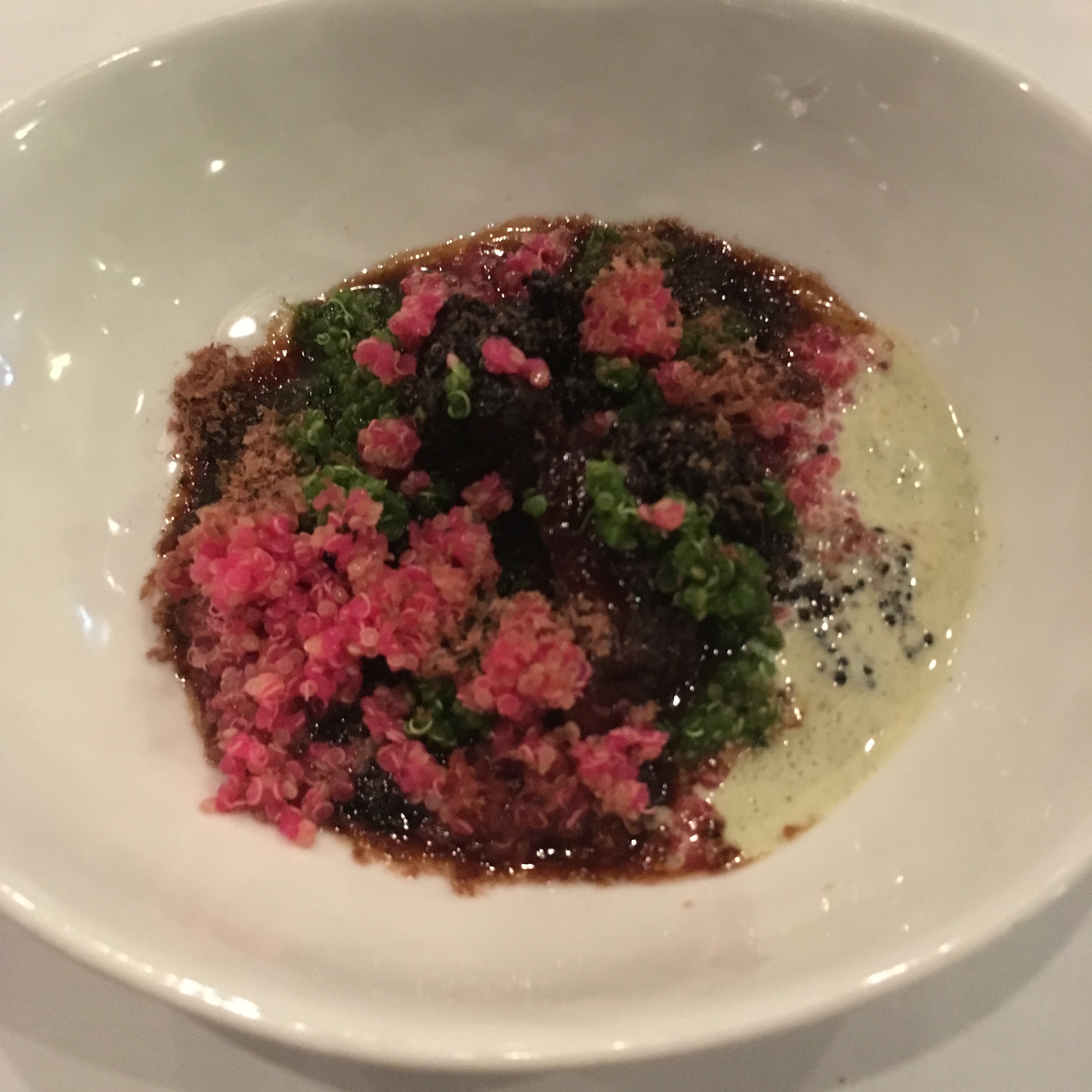
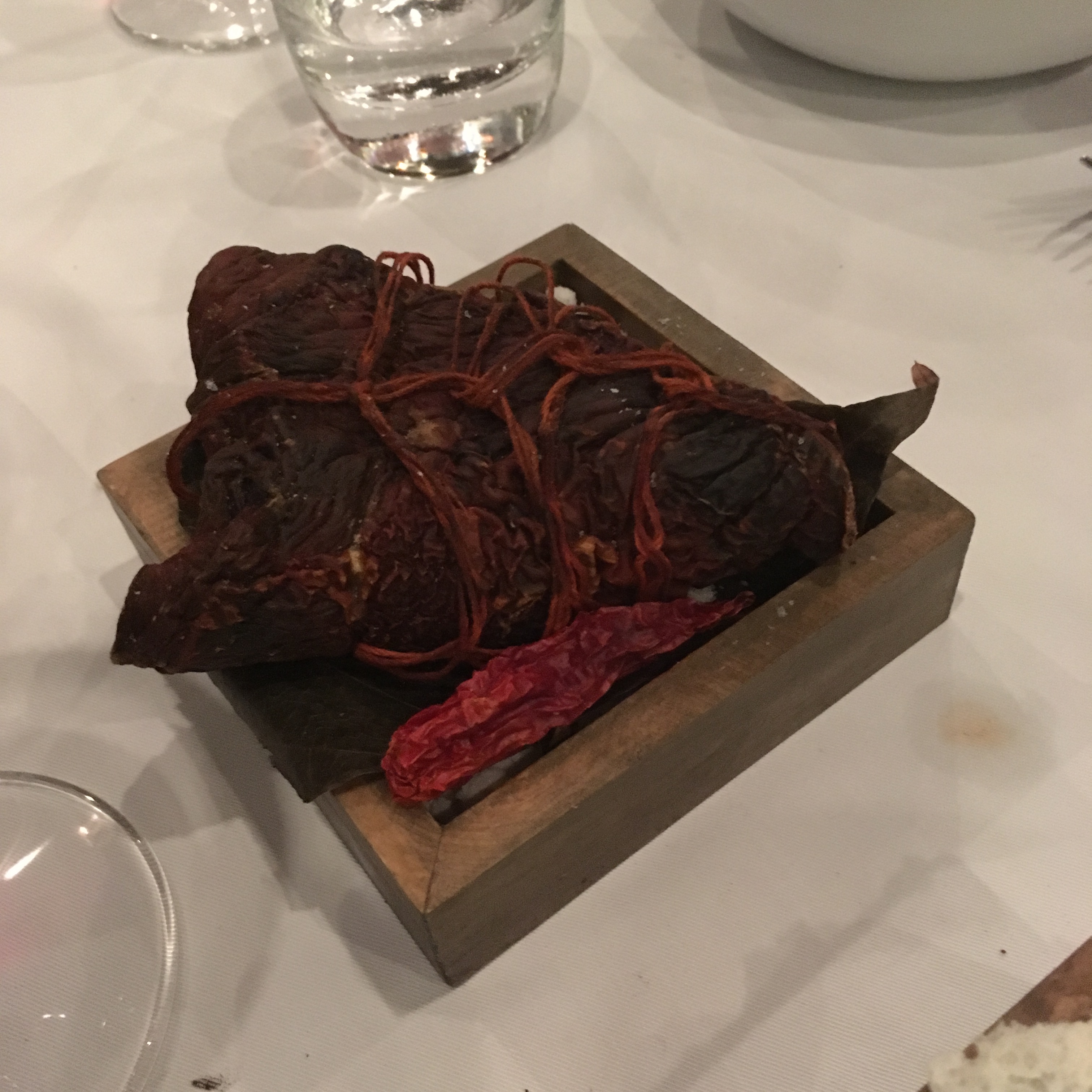
We were also given some crackers of dehydrated quinoa milk, which we crumbled into the dish.
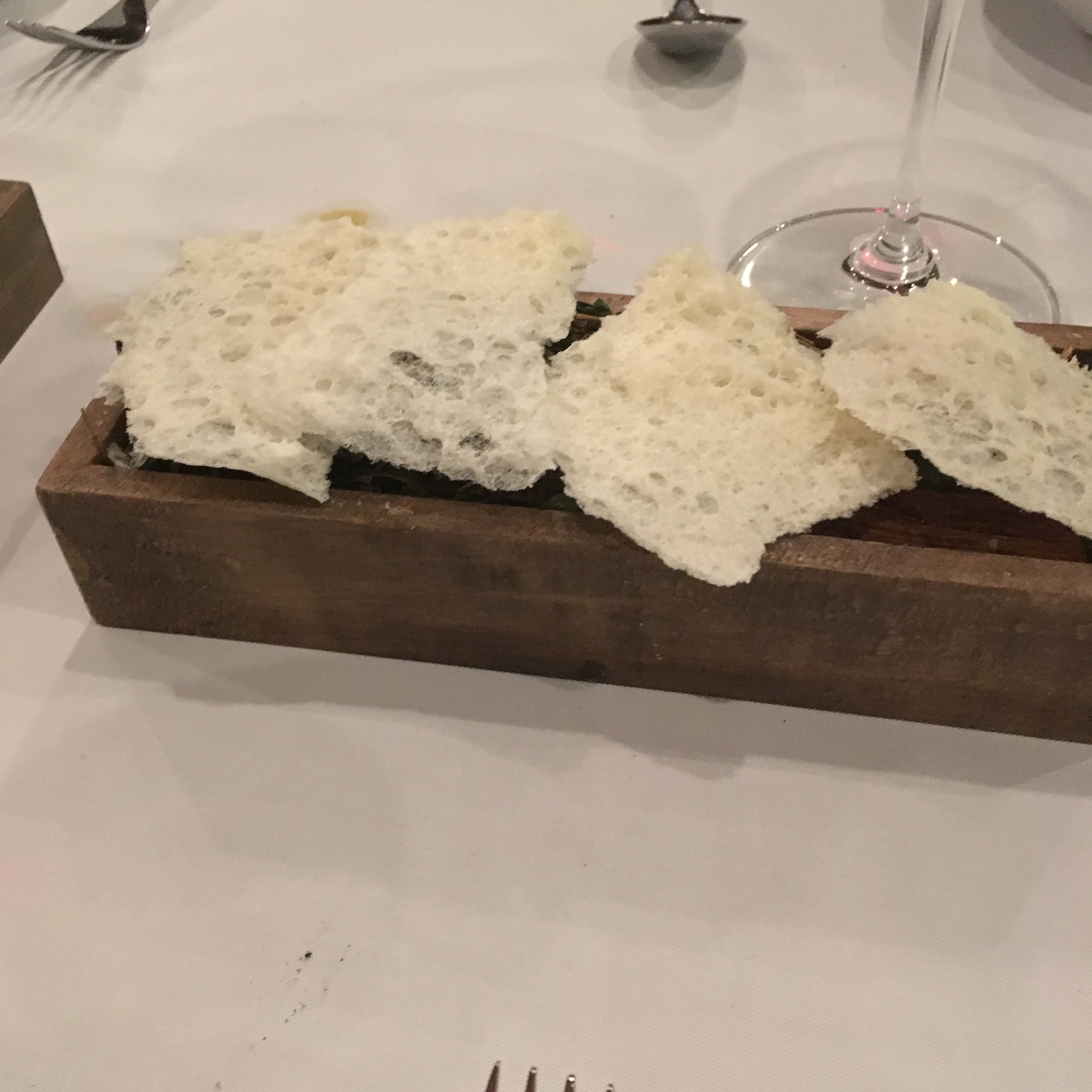
Was getting late, so I finally forgot to snap a picture of this one. But it was the first desert, and just stunning. There was a sphere of rose apple and pitahaya (dragon fruit) which was something like a super fine grained, loose granita, dusted with a very slightly spicy bright pink dried chili. Then next to that there were slices of dragon fruit, layered with a rose apple custard, and topped with a dust of yierba luisa (translated on the menu as lemon grass, but I think it’s closer to lemon verbena—it’s a tall grass, not a stalk, and it’s one of my favorite Peruvian herbs) and baby chamomile flowers, super tender flavor explosions.
Non hyperbolically, this was one of my favorite deserts ever. Seriously. FANtastic. A sphere of incredibly creamy and intense chocolate ice cream, bitter and rich, was coated in slivers of sweet and creamy white chocolate, dusted with green chaco clay (I’m sure it added something to the dish, but I don’t know what. Hey, whatever, it worked). So much chocolate flavor. So creamy. So rich.
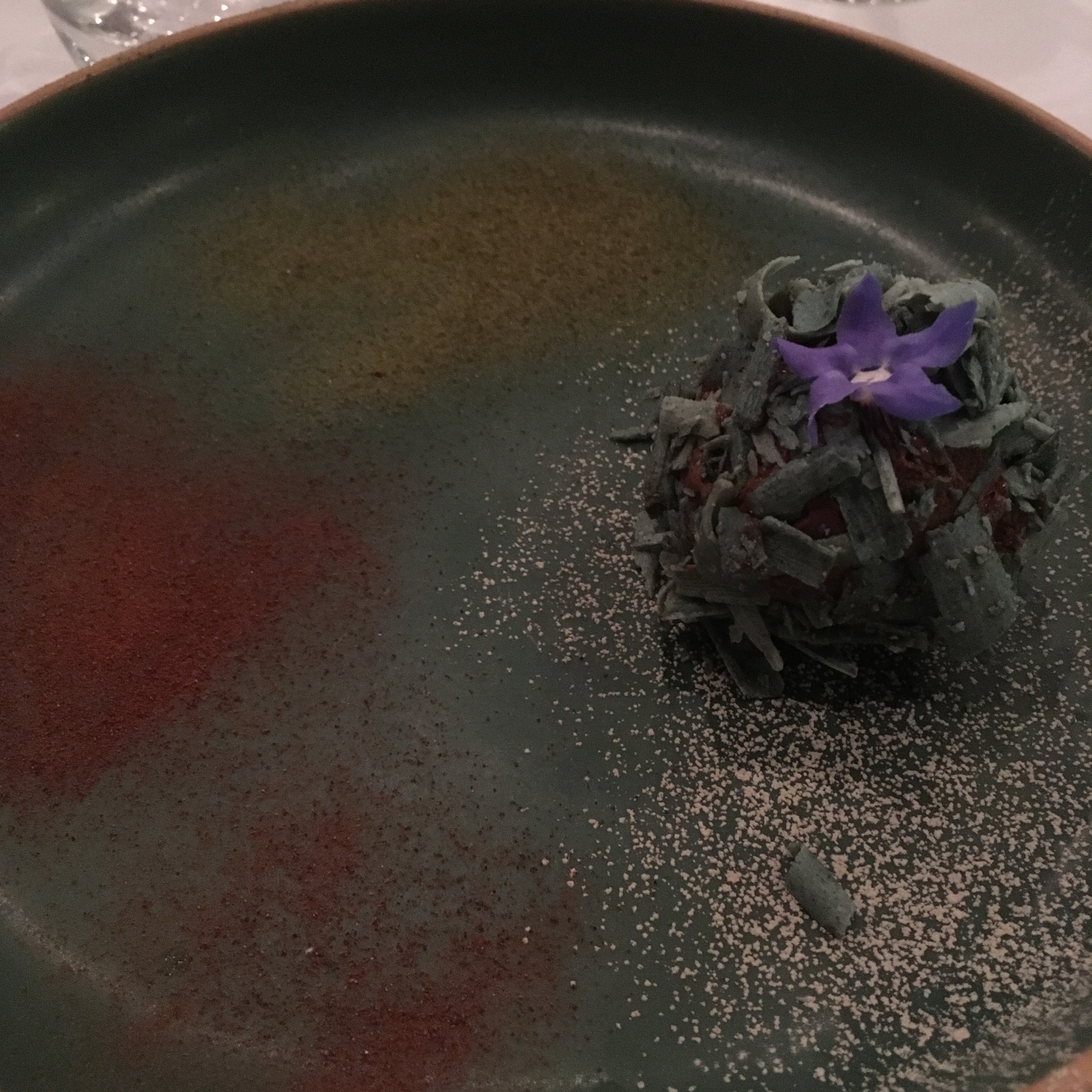
On the side, there was a cold tea of muña (that bitter Andean mint), which the waiter spooned little balls of cushuro (a lake algae) into. Like a scrumptious tiny bubble tea.
To be honest, the petit fours were our least favorite course. A shame since the other two deserts were STUNNING, but still they were pretty neat.
A granadilla jelly, covered in chocolate with some green cacoa on top, and a chocolate bark with sacha inchi (Andean peanuts) and yierba luisa.
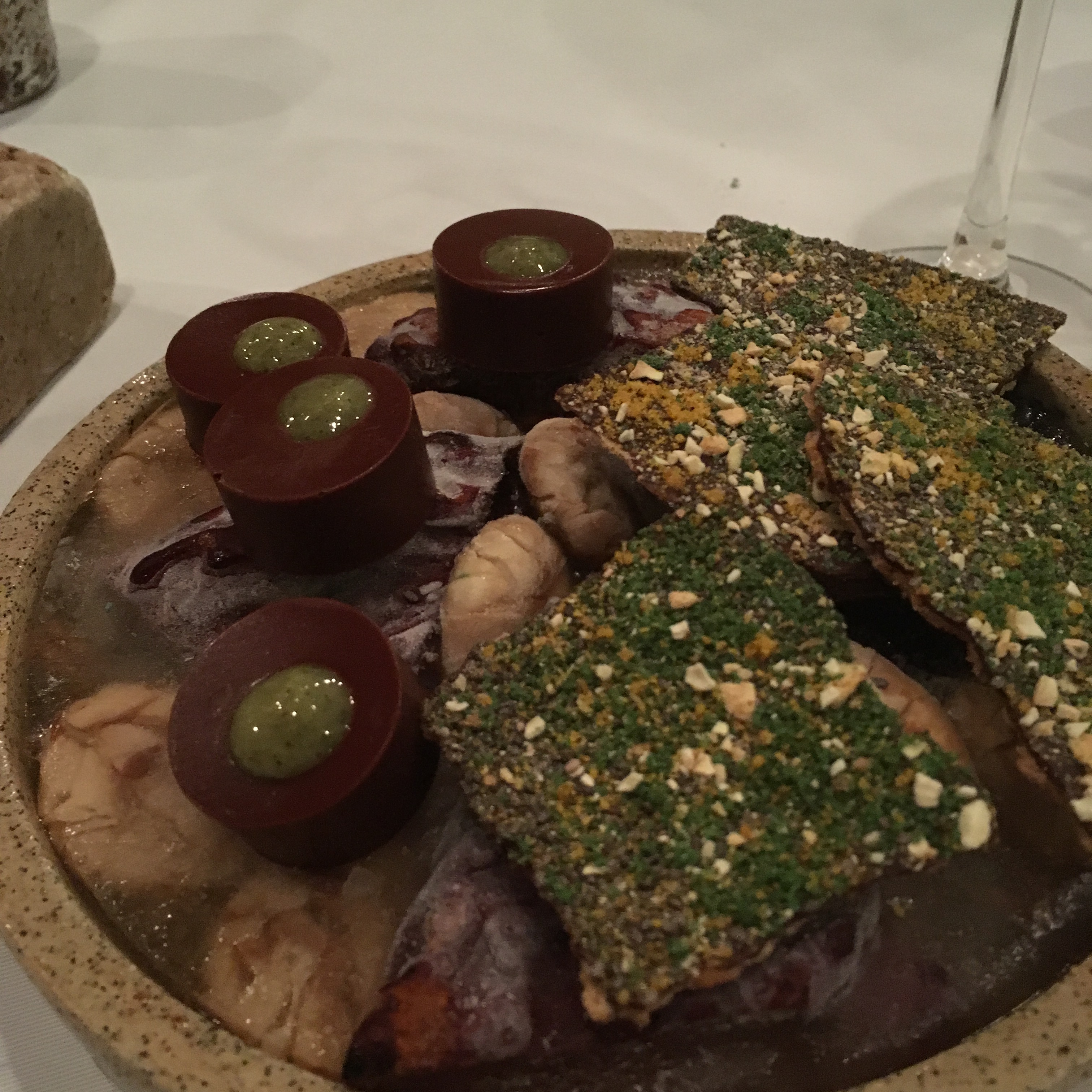
A jelly of intensely flavored chamomile (great flavor, ok texture)
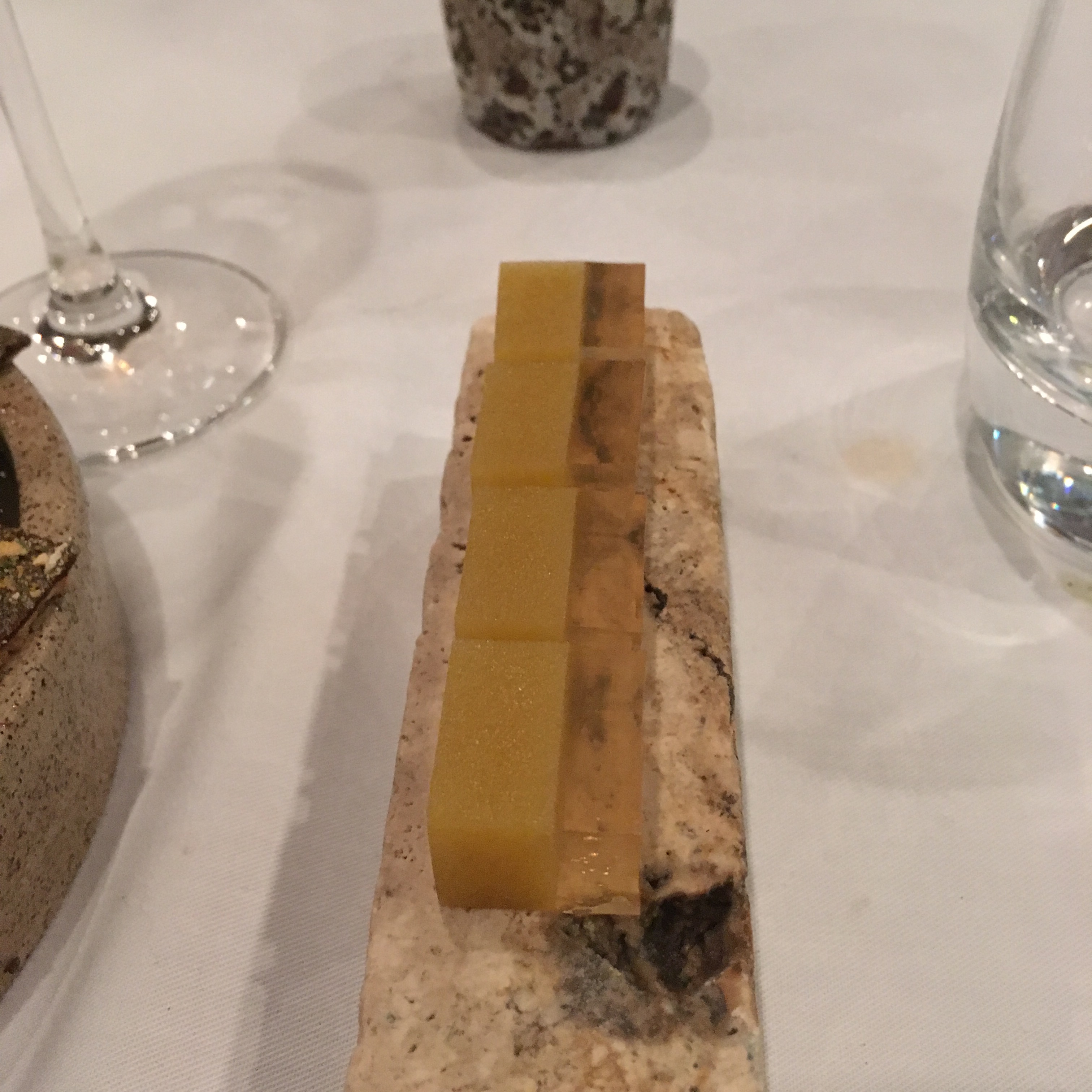
A dissapointingly chalky cube of chirmoya candy, coated in maca.
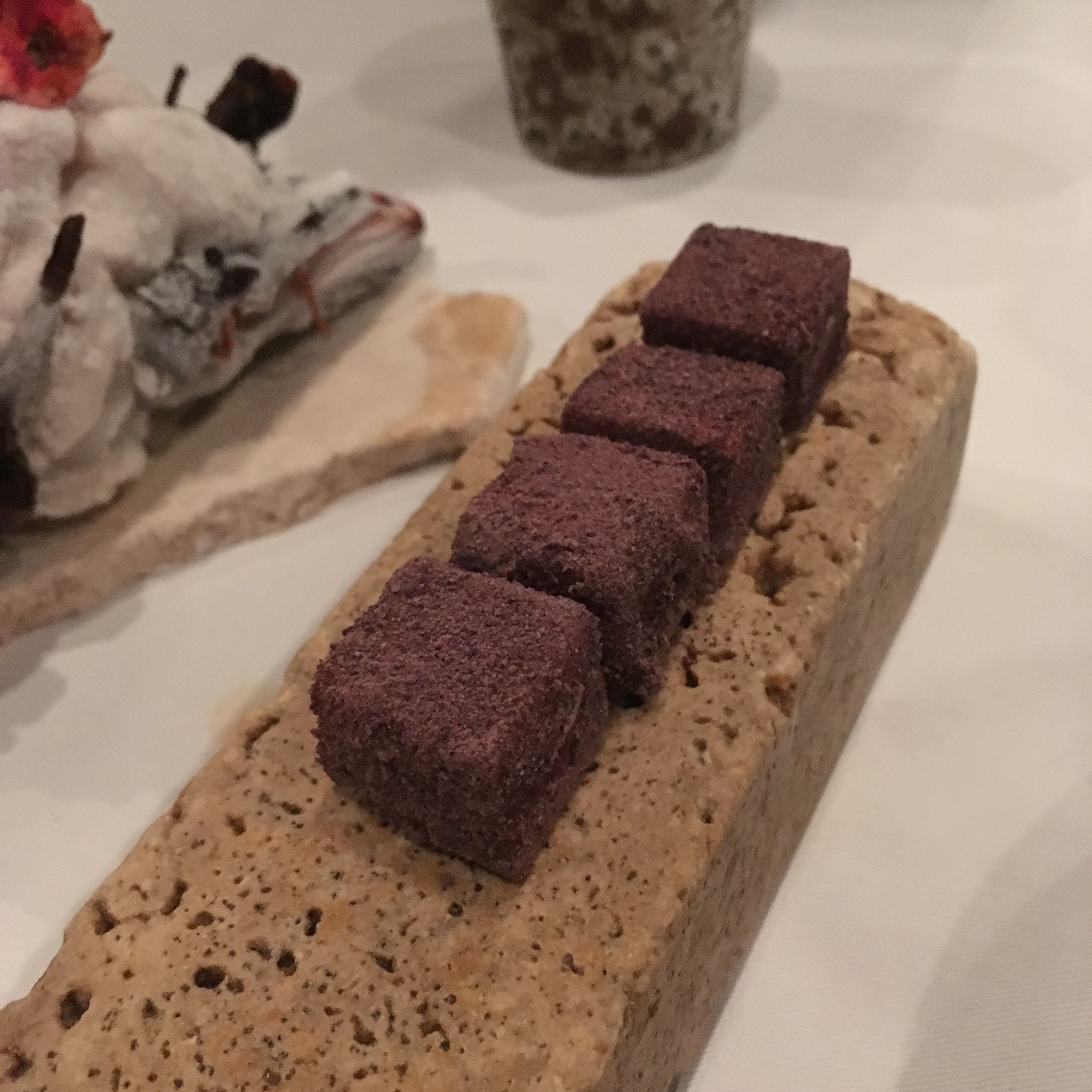
And a super delicious little chip of one of the tubers (I believe oca), with a syrup made from the same tuber.
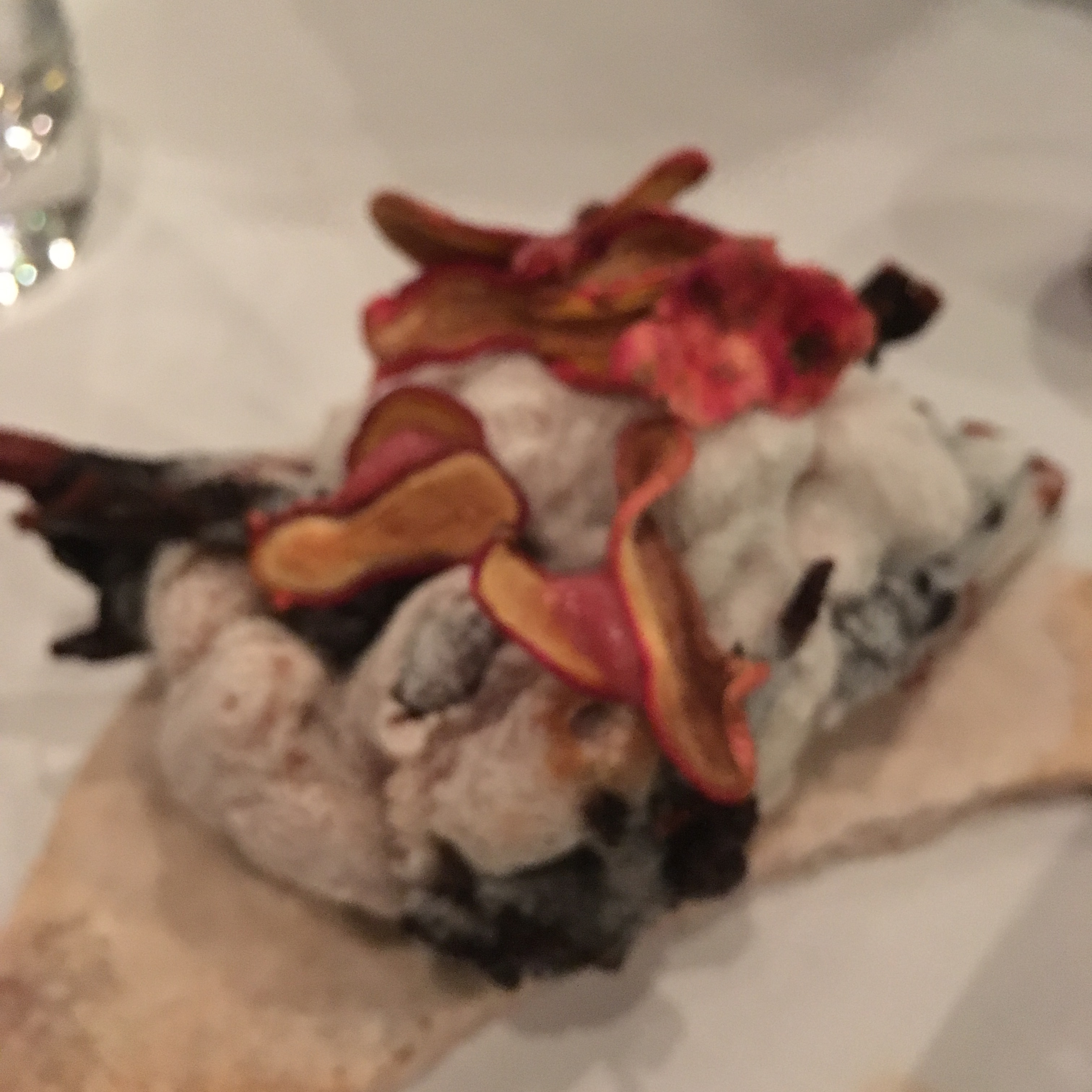
Along with the petit fours was a delicious shot of a refreshing drink, made from another lemony herb (cedrón, very similar to lemon verbena) and mucilage, which is the mucous around cacoa seeds. When it ferments (as the seeds dry), it gives a lot of the flavor subtleties to chocolate. Unfermented, it was crisp and refreshing.
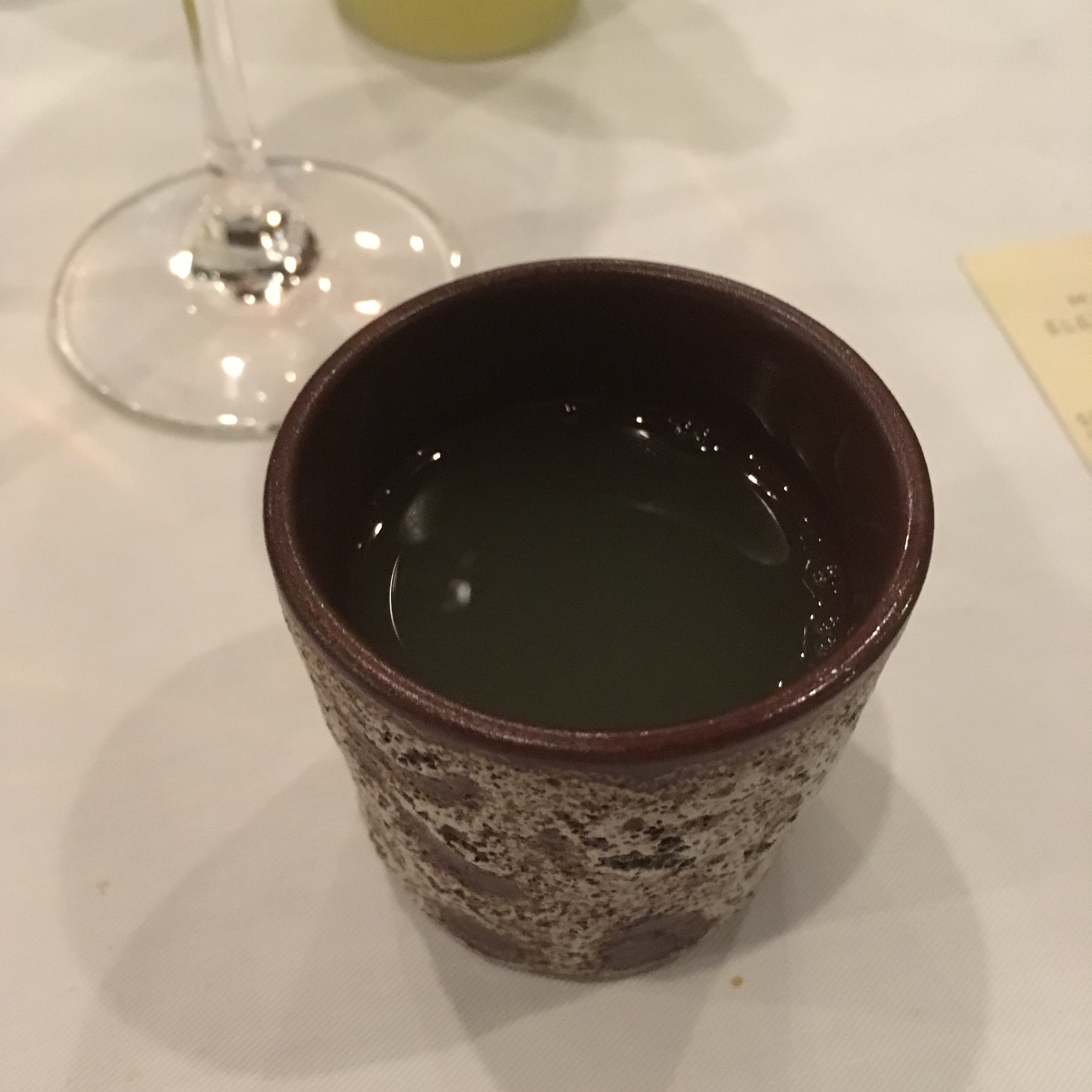
I ended the meal with a sip of our 11th drink in the pairing, a superb Pedro Ximénez sherry, which was the best desert one could ask for.
We will definitely be back. One of the most suprising, delightful, delicious and memorable meals of my life. Can’t wait to eat here again with you.
